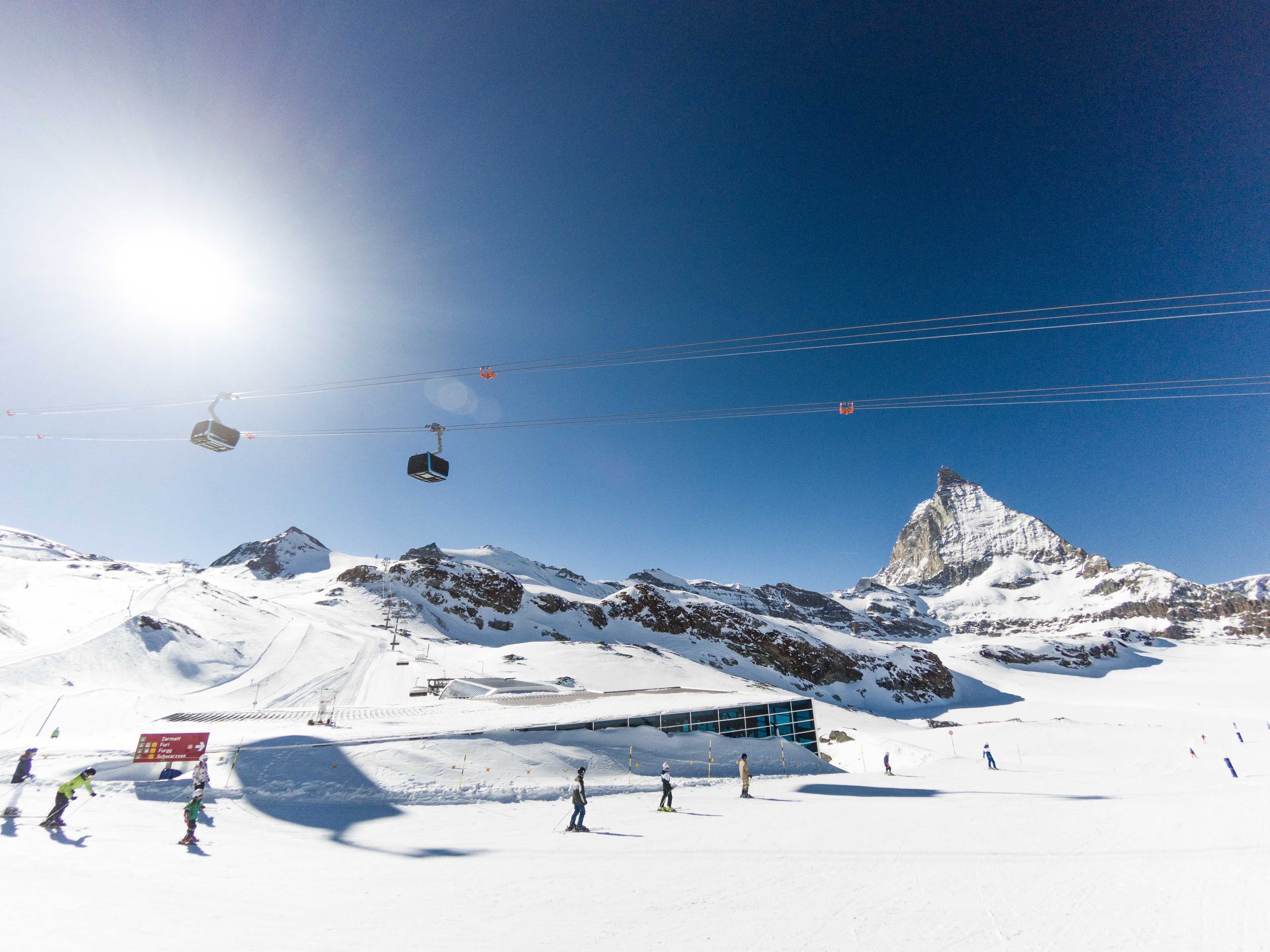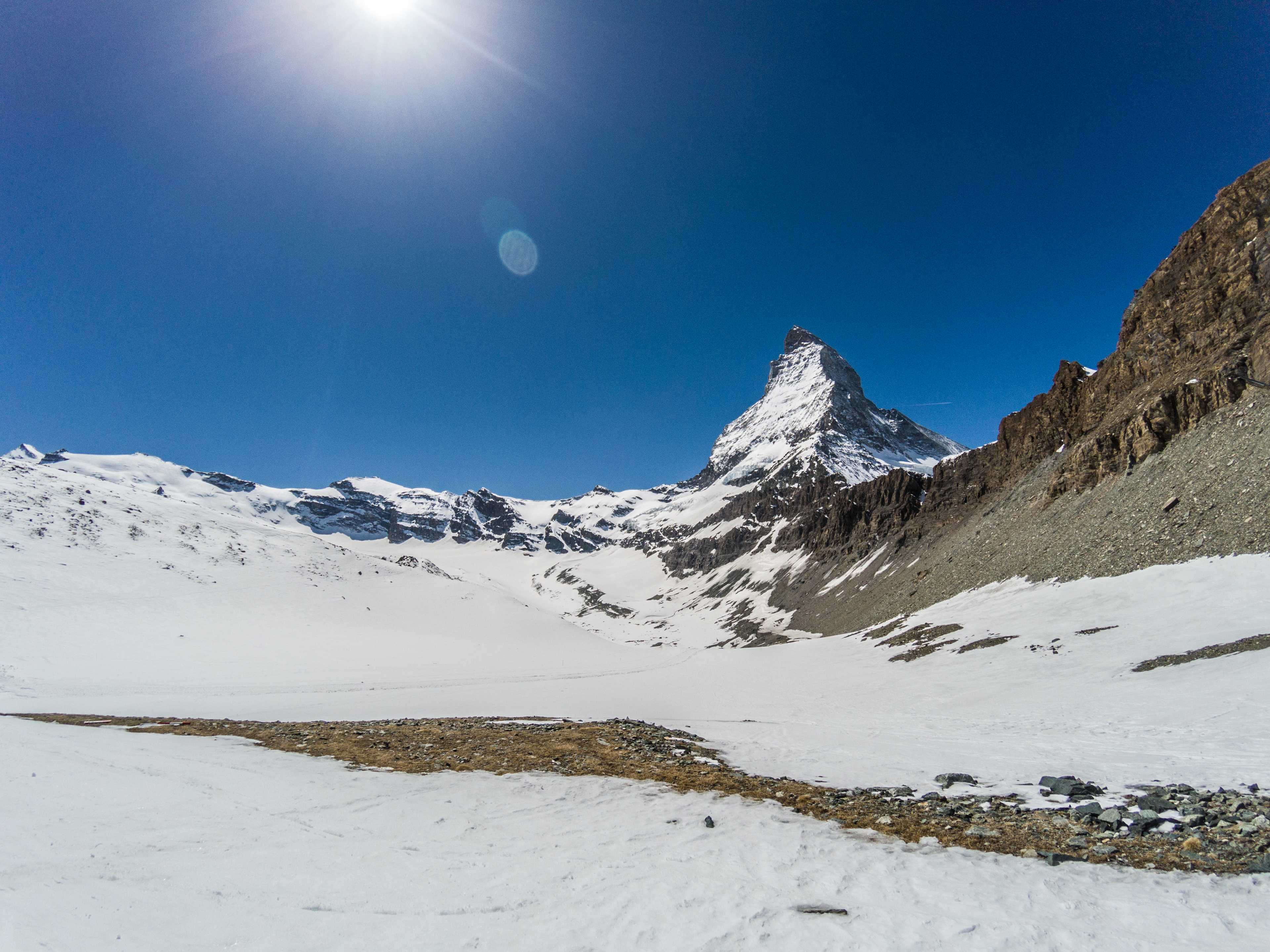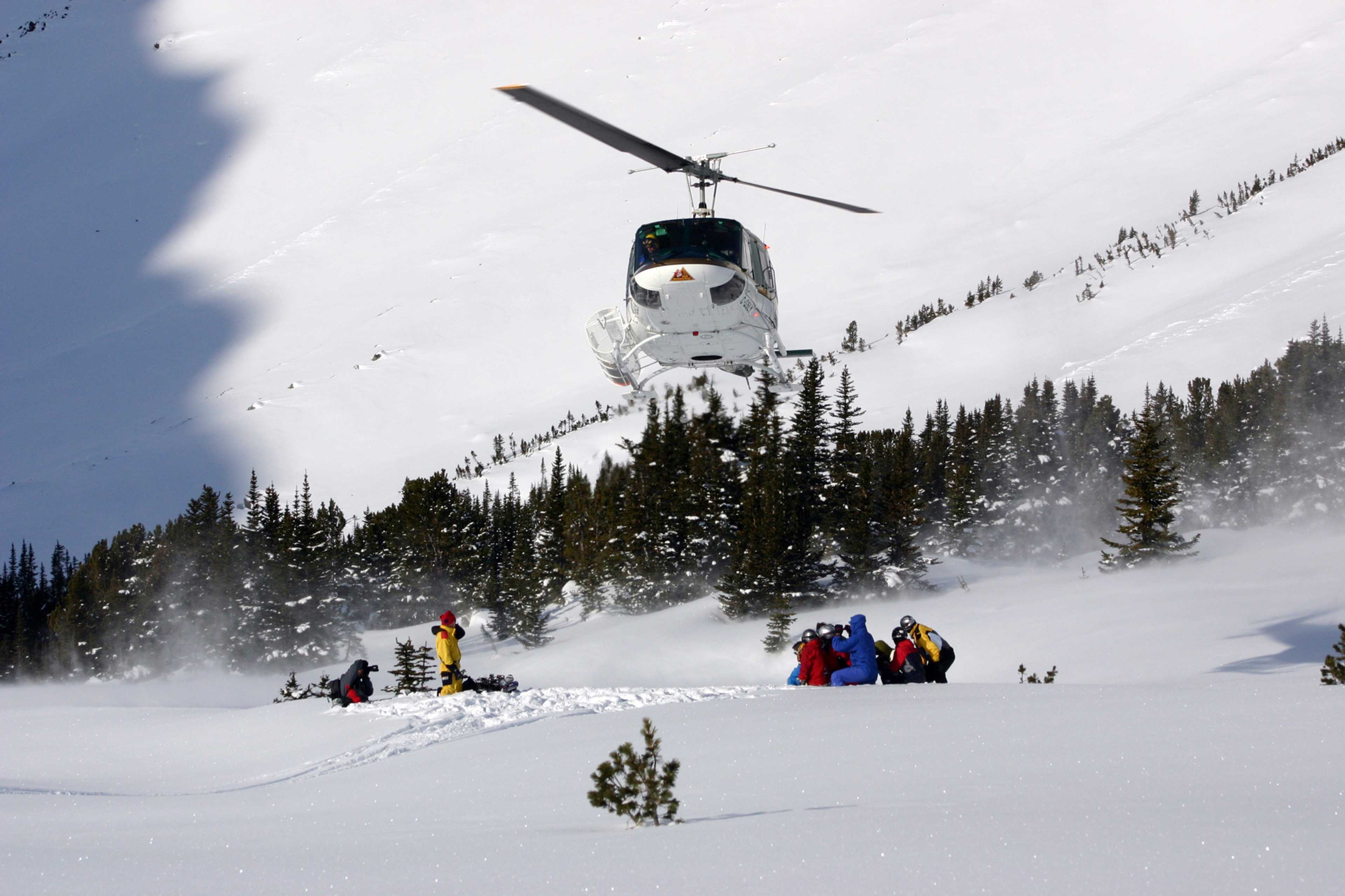The Aosta Valley is still a little-known region of the Alps among European winter sports fans. This is mainly due to the rather limited access. No wonder: in this region there are the highest mountains in this part of Europe and getting here can be troublesome. We had an opportunity to write about nearby Cervinia some time ago. This time we decided to check out the neighboring Monte Rosa massif, the mecca of Italian freeride and a group of resorts united under the name Monterosa Ski. A place that appears in rankings of the most challenging ski resorts in Italy. Is it rightfully so? We checked.
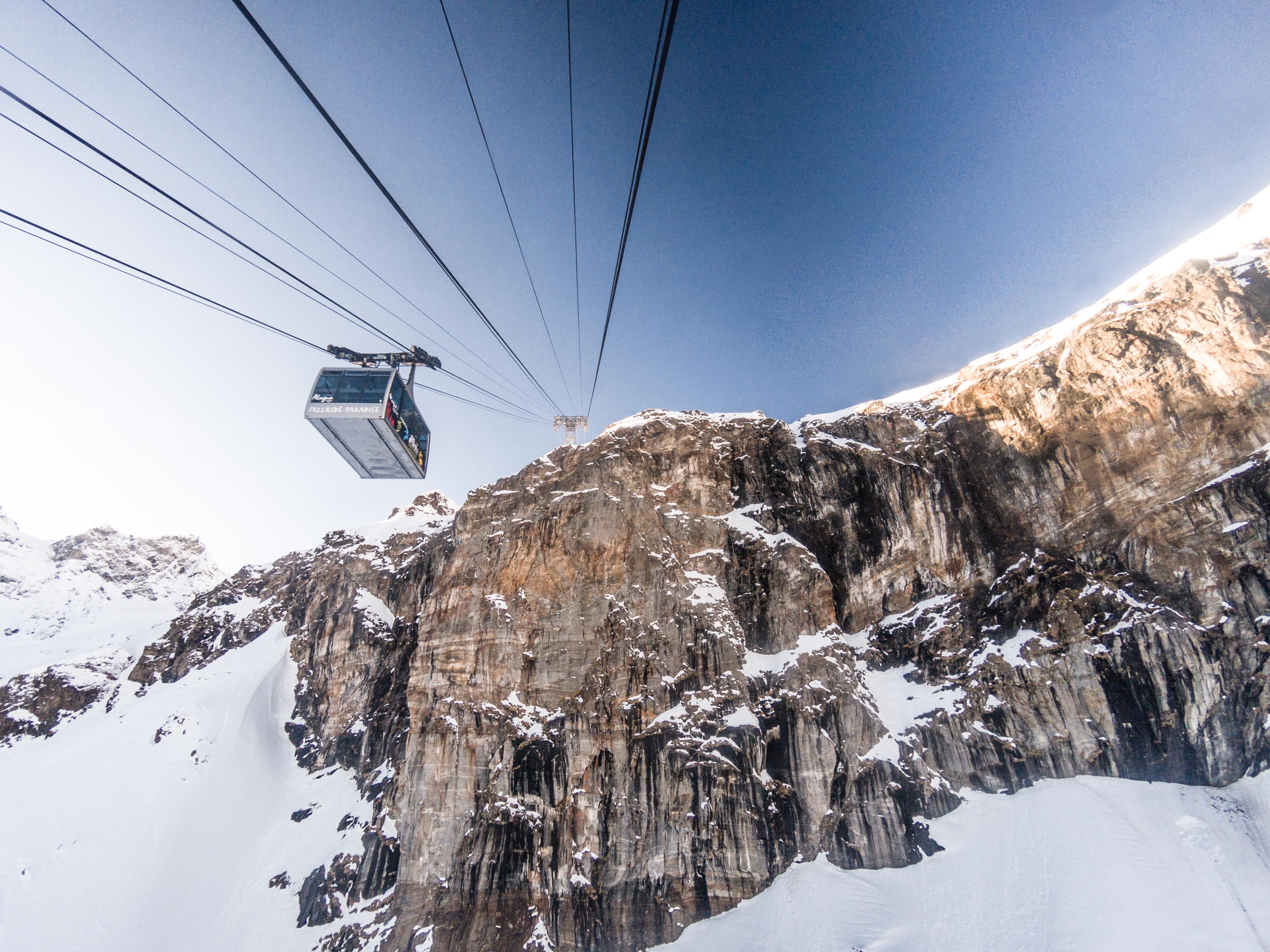
Location
Monterosa Ski comprises of actually three valleys - looking from West to East: the Val d'Ayas (Frachey, Champoluc, Antagnod), Valle de Lys (Gressoney, Stafal) and Valsesia (Alagna). Culturally, it is a very extraordinary place. The Aosta Valley is a region where one will encounter two official languages - French and Italian. Meanwhile, in French-sounding Gressoney, instead of French, we will encounter Walser culture, historically linked to the German-speaking areas of Switzerland. The last valley (Valsesia), on the other hand, is already a region of Piedmont, where the Italian language reigns supreme. Each valley represents a different culture, a different cuisine and different skiing opportunities. Due to the relatively close proximity of Cervinia (only 6 km as the crow flies), the Aosta Valley authorities are considering the implementation of a €50 million gondola railroad connecting the two ski areas. If the investment were to come to fruition, Switzerland's Zermatt, Cervinia, Valtournenche and the slopes of Monterosa Ski would create a ski super-resort offering more than 450 km of runs.
Getting there
All three valleys can be reached from the south only. The first two can be accessed from the A5 highway connecting Turin and Courmayeur. Valsesia can be reached from the A26 highway near Novara and Milan. Getting to Val d'Ayas and Valle de Lys by car is quite expensive - we will pay more than 17 euros for the highway on the Milan-Pont-Saint-Martin section. After that, we still have more than 30 km of a local, curvy road. Getting to Valsesia, on the other hand, we have to set ourselves up for a much longer drive on local roads, but in more accessible areas. Let's also set ourselves up for unfavorable meteorological conditions - this is the most snowy region of Italy and having chains is required here from October. You can read more about getting around Italy in our guide.
Getting here by car from the north is quite a challenge - you have to go around part of the Alps and the whole road extends by about 150 km. It is worth dividing this distance into two sections, because in the last part of the road a lot of surprises related to the weather can wait for us.
Those who decide to arrive by plane have an airport in Turin or Milan at their disposal. From low-cost Bergamo you have to reckon with a more than two-hour commute by car. The region is poorly connected by public transportation to major cities, so it's worth renting a car and getting to the resort on your own.
Accommodation
Monterosa Ski is a hidden gem of local skiers - even in the highest season crowds will not be found here, and the predominant group of tourists are Italians. As a result, the accommodation is not prepared to host large numbers of visitors. Hotels and pensions are concentrated along the three valleys. When searching, it's worth taking a look at the local tourist association search page. In guest houses and pensions, be prepared that knowledge of English is not common, and you may have to communicate in Italian, German or French.
Accommodation prices are considerably lower than in nearby Cervinia, but the resort also offers far fewer runs and even less apres-ski infrastructure. Accommodation is best sought directly in Frachey and Champoluc (Val d'Ayas), Stafal and Gresoney-La Trinité (Valle de Lys), and Alagna Valsesia. Deciding to stay in farther towns, let's set ourselves up for independent access or use bus transportation (in practice, one bus per hour).
Pistes
Monterosa Ski is a group of several ski resorts, most of them interconnected. The main ski area comprises of Frachey/Champoluc - Gressoney - Alagna. In addition, as part of the skipass we get access to much smaller ski stations in Antagnod, Brusson/Estoul, Gressoney-Saint-Jean and Champocher. In this article, I will focus on the main area. I left the smaller stations (consisting of 2-4 ski lifts) for another trip ;). Due to the very particular terrain, a common feature of the resort's slopes is their length. In fact, each slope is more than a kilometer (and often more than 2-3) long. It is one of the few resorts where it is easy to spend more time on the slope than on the lift. To me this is one of the main advantages of this place. In particular, the slopes meeting at Stafal/Gressoney can be characterized as one big ice desert. These are truly unique views that immediately bring to my mind Plateau Rosa and Plan Maison in Cervinia. Due to its special location, it's a place where snow appears as early as November and disappears in May. Being in January, I had the opportunity to admire a three-meter layer of snow in the upper areas. In Gressoney, on the other hand, "only" one and a half meters.
Each valley of the main chain of resorts offers different slopes and different attractions. Going from the west, Frachey/Champoluc are two interconnected ski stations offering mostly red slopes. Gressoney-La Trinite, the middle valley, features more difficult red and black slopes, but also the access point to the other valleys. It's a perfect place to reach the resort's biggest attraction - Passo Salati and Punta Indren, but more on that later :). Alagna is basically just 4 slopes starting at Passo Salati.
Regardless of the ski area, all the trails were perfectly groomed and offered a very good experience, They were wide, level and beautifully situated. More bumpy experience came after the nightly, very heavy snowfall. The slopes are prepared just after the resort closes, after 4:30 p.m. Unfortunately, the day following the night snowstorm, the slopes were full of powder and ungroomed snow. This is unfortunately normal in most resorts and is exactly what I experienced in other Italian resorts. Nonetheless, the quality of the preparation of the trails is top-notch, and I can only remark on their signage - there are a little too few of them (but it's more a matter of getting used to it) and they are based on names rather than symbols or numbers (which makes it much more difficult to remember and identify the names, especially for those who don't speak French). Interestingly, the trails have their own symbols on some maps. Unfortunately, we will not see them on the signs or on the website - they are usually identified by their names only.
In the rest of this article I will use the labels from the resort's maps, which can be picked up at the ticket offices or seen at the transfer stations. However, I will try to use the full names as well, to make it easier to find your way around :).
Frachey-Champoluc (1579-2727 m a. s. l.).
This is the area offering the greatest variety in terms of pistes. Despite the essentially continuous red marking of the trails, there is something for every intermediate skier. Frachey and Champoluc are connected to each other by an old two-person chairlift stretched between the hills, which can be accessed in both directions at its midpoint located in the valley. Here the queues are already visible, but still in the morning peak waiting time did not exceed 10 minutes.
The ascent from the most distant Champoluc is accessible via a modern gondola lift that was rebuilt in 2018. We get to the highest point (Sarezza, 2702 m a.s.l.) by a second, newer gondola lift, followed by a chairlift. From the top itself, we have very pleasant red trails all the way to Champoluc itself. Wanting to get to Frachey, we have to go down a rather difficult slope marked C6 (Sarezza-Contenery). Now this is not a piste for everyone and less advanced skiers living in Champoluc should get to Frachey by bus or car :). It is a distance of about 2 km.
The ascent from Frachey is made possible by a funicular, which suffered a major breakdown in January 2018 and was out of service for an extended period of time. For this reason, the lifts in Champoluc were open longer so as not to shorten skiers' time in other valleys - a courtesy on the part of the resort. The upper station of the chairlift is also the valley station of the four-seat Alpe Mandria chairlift - the most important in this area. Leading to Mont Ros (2457 m a.s.l.) is basically the only lift that would need to be replaced immediately due to insufficient capacity. Here, basically regardless of the time of day, we will face a queue (even more than 20 minutes). This is a very big disadvantage, since the C11, C16 and C10 pistes are excellent for everyone. One of the slopes hosts slalom runs and competitions. The others are long ski runs (red and blue). There are several options, and if it weren't for the fact of permanently waiting in line for the ski lift, I would spend a lot more time here.
From Mont Ros, a pleasant C13 ski run takes us easily to a long chairlift leading to Colle Bettaforca (2727 m a.s.l.). This is the meeting point with the next valley. From the top station we can descend excellent pistes both back to Frachey and to neighboring Gressoney. From both sides the lifts are very long and are gradually aging, but at the same time they are quite efficient and there are no queues at all. To Stafal (Gressoney) you will only go down the difficult pistes B3 and B6. Less advanced skiers should definitely take the cable car down.
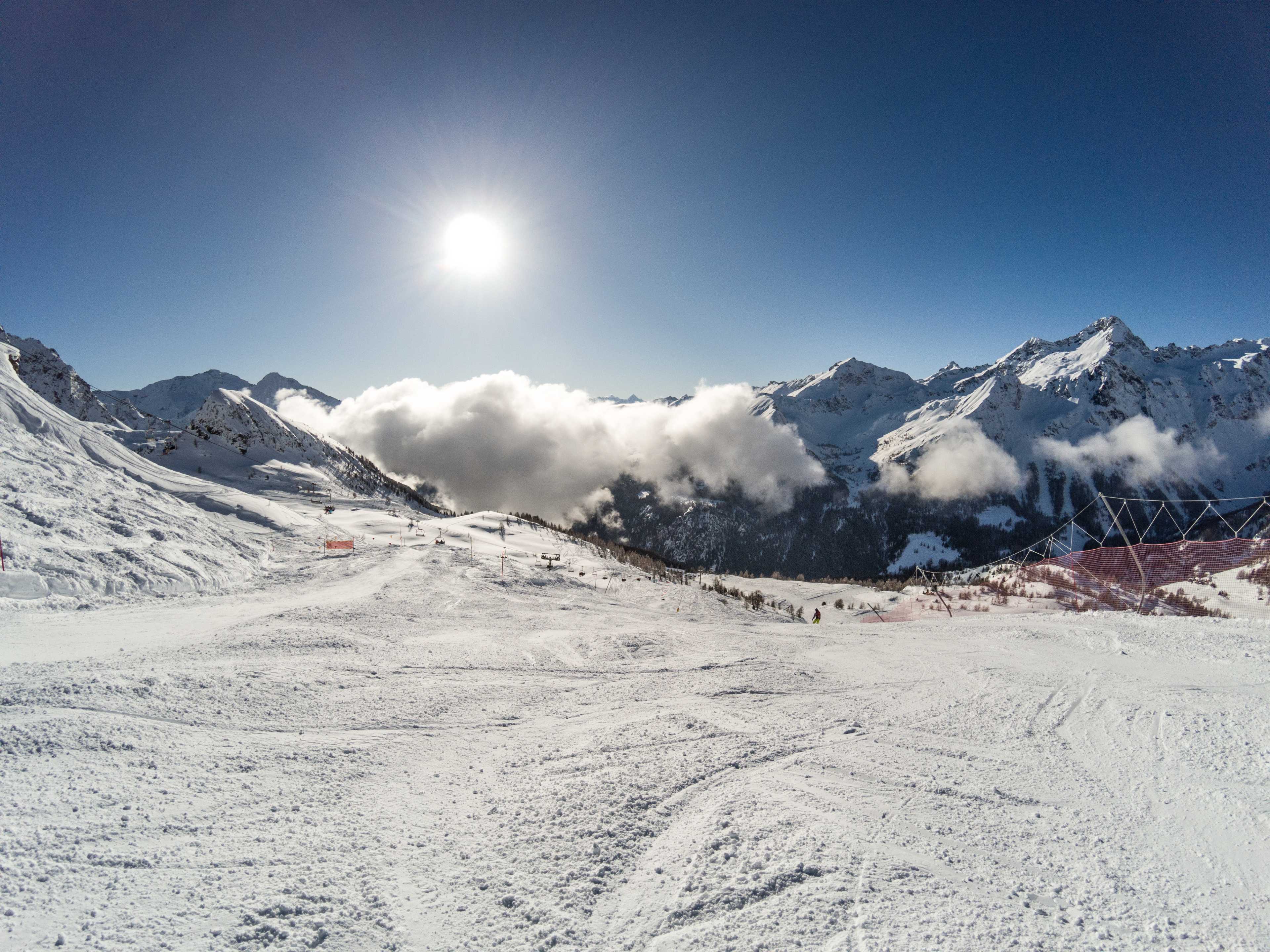
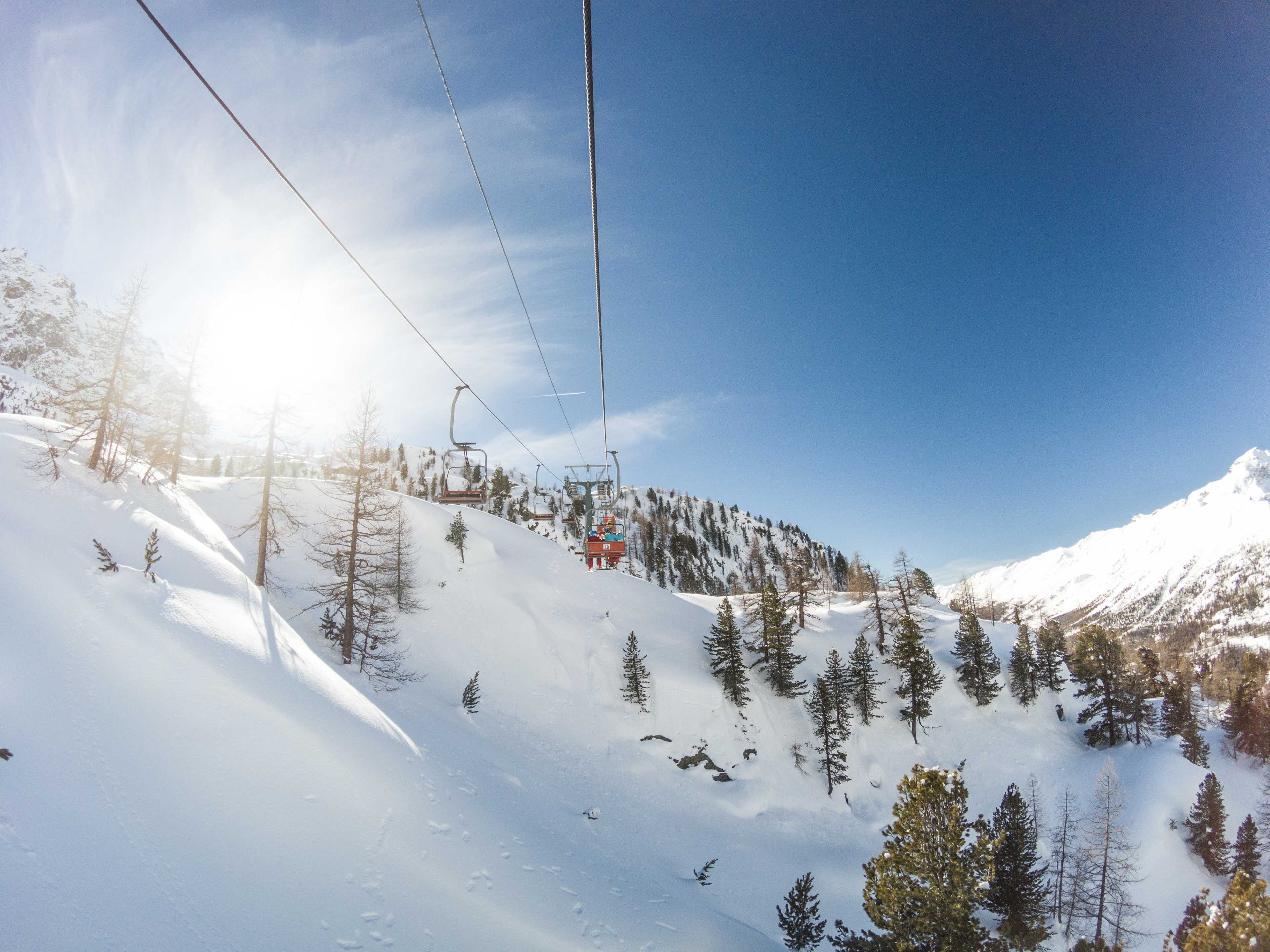
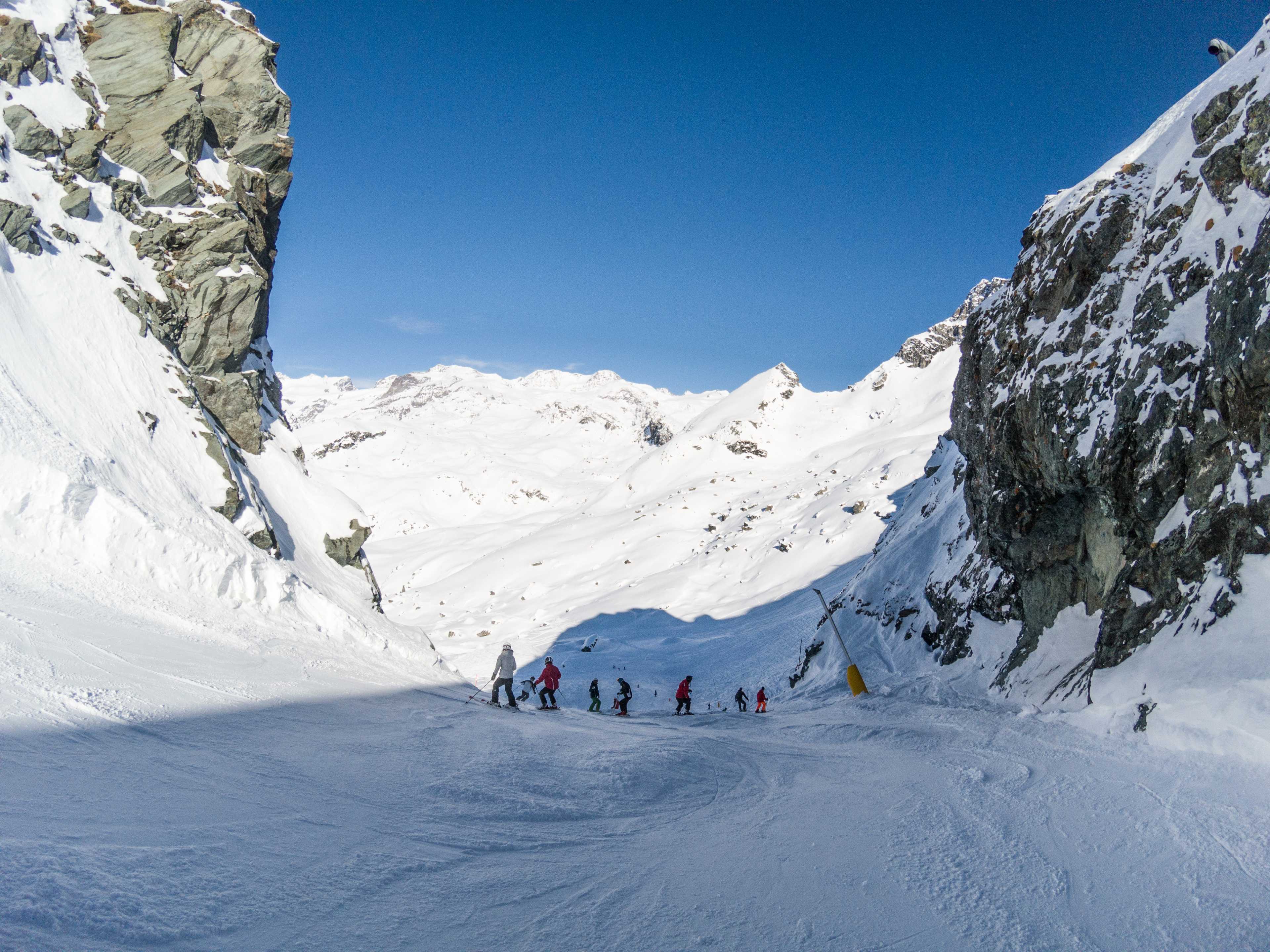
Gressoney-La Trinité (1637-2971 m a.s.l.).
This is probably the most strategic location. The lift stations leading toward both Frachey and Alagna are a few meters apart. To reach Frachey, first we have to take the old aerial tramway leading to Sant'Anna station. This cable car is also a bottleneck within the three valleys. In the context of building a connection to Cervinia, it is cited as a necessary investment to accommodate more skiers. Even so, there were no queues here, and the only time you spend at the station is waiting for a slow cabin.
Towards Alagna (Passo Salati) we will take an efficient, new 8-passenger gondola lift. The transfer station is Gabiet, located at 2318 m a.s.l., from where we have access to a good number of slopes of Seehorn (2390 m a.s.l.) and Punta Jolanda (2278 m a.s.l.). From Gabiet we also have a 12-passenger gondola lift to Passo Salati (2971 m a.s.l.). Along the gondola lift from Passo Salati, all the way to Stafal, we have a huge piste marked sequentially as G8, G7, G5 and G6. The first section (marked in red G7 and G8) is a very pleasant run, which can confidently welcome less and more advanced skiers. The lower section marked G6 (marked black) is already intended for thrill lovers due to several steep parts.
The slopes from Seehorn and Punta Jolanda are the most noteworthy, where we have red and black marked pistes. The runs are very pleasant, long, and every intermediate and more advanced skier will find something to his liking. The downside is the old and slow chairlifts, to which, admittedly, there are no queues, but the ascent time exceeds 8 minutes.
If you have booked accommodation in the village of Orsia (Gressoney), where accommodation prices are lower, there is an old ski run from the bottom station of the Bedemie-Seehorn chairlift along the now non-existent chairlift. The piste is officially closed (a sign confirms this), but it is a groomer's road and allows a safe descent all the way to the road (opposite the Residence dei Walser guesthouse). This is an important alternative to the official descent to Gressoney-La Trinité, from where a bus will take us every hour to the next villages in the valley.
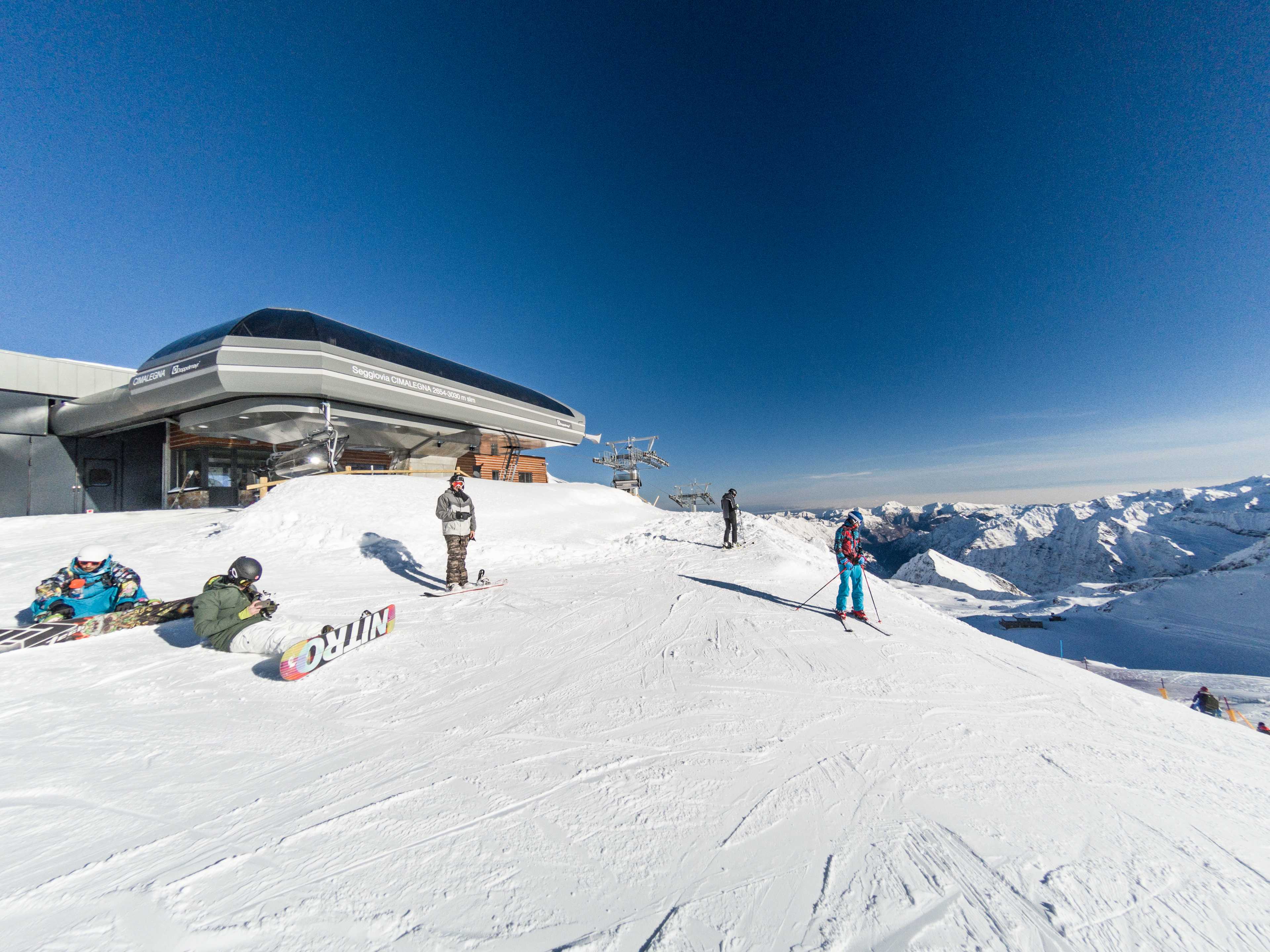
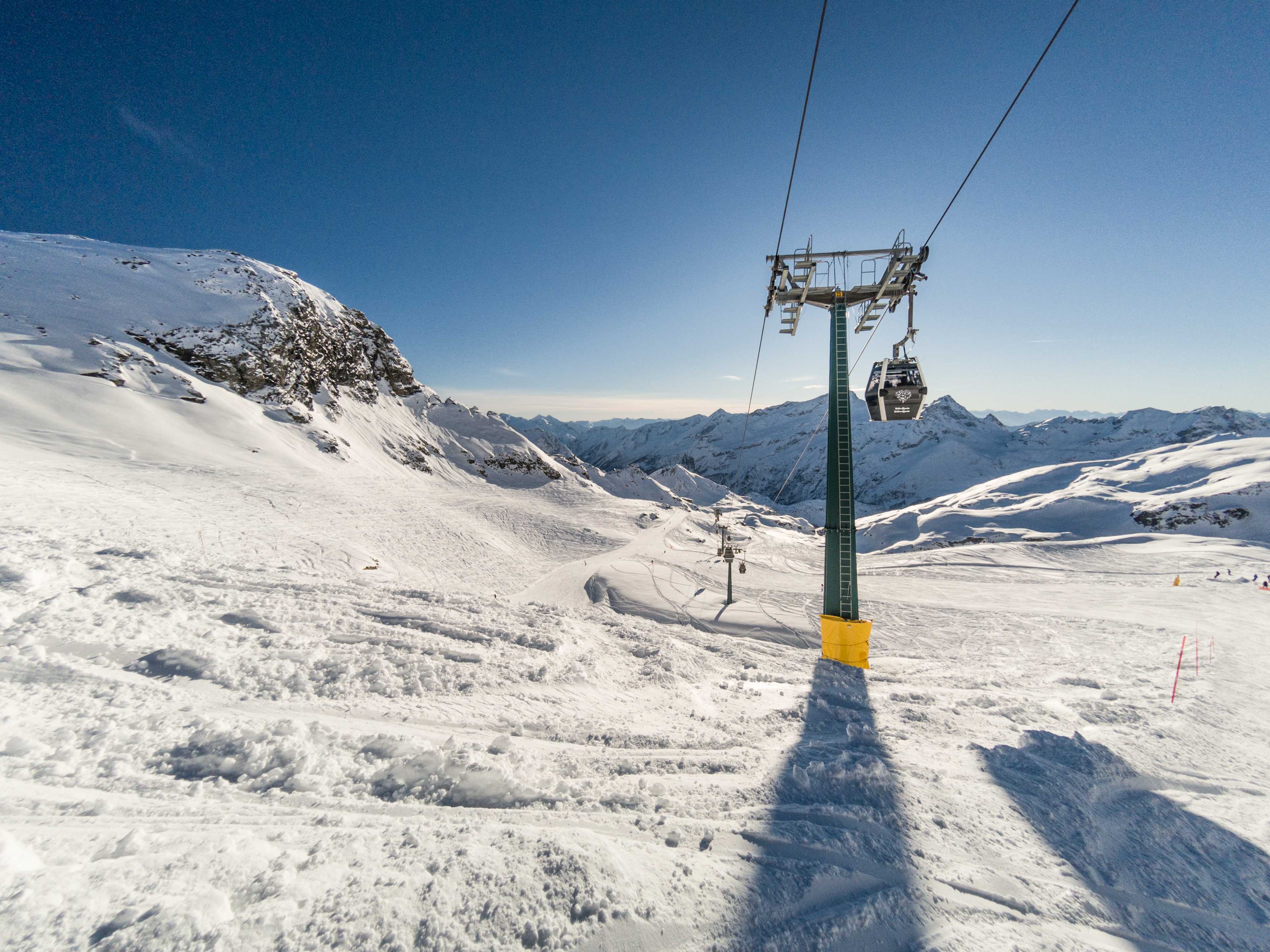
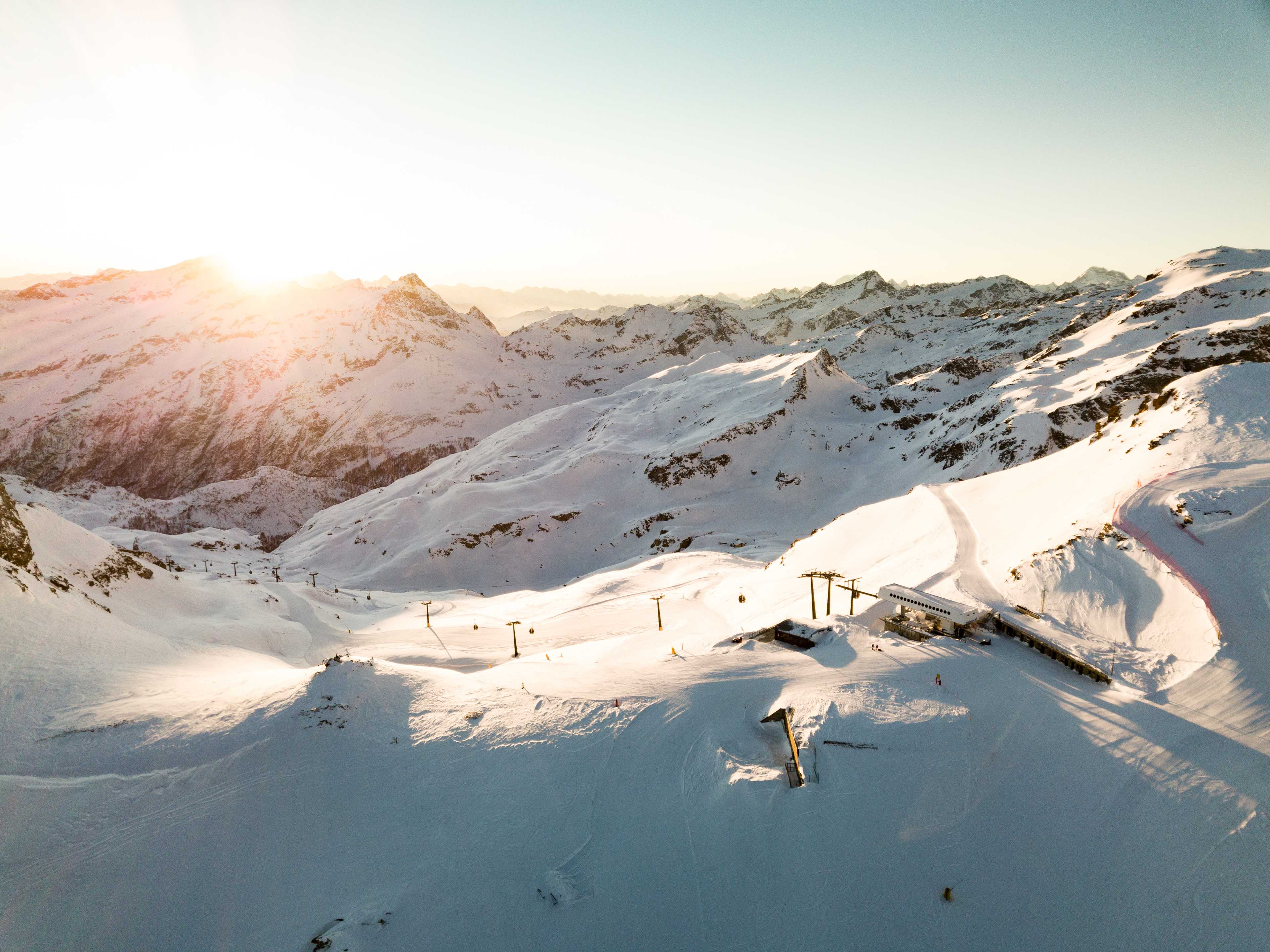
Alagna Valsesia (1212-3030 m a.s.l.).
The western part of the complex begins at the highest part of the resort, Passo Salati, and ends at Alagna (the easternmost part). From Alagna we will get to the top by an 8-passenger gondola lift to Pianalunga (2046 m a.s.l.). From there we'll take a very efficient funifor cable car to Passo Salati (2971 m a.s.l.), which has an intermediate station on a support on the Cimalegna rock (2650 m a.s.l.), where it often ends its course. From there, parallel to the second section is a modern 4-person high-speed chairlift, commissioned in the 2017/2018 season, leading just above Passo Salati - at 3030 m a.s.l.
From Passo Salati we have two blue runs (V4 and V5) leading to Cimalegna - very wide and less demanding, ideal for less advanced skiers. From one branch of the blue route to Pianalunga we get an excellent V3 black route. From there, a very long red route V1 leads to Alagna - despite its length, rather nothing exceptional, also due to the large difference in altitude and significantly deteriorating conditions. Indeed, its end is at an altitude of 1212 m a.s.l. and it is the lowest part of the resort.
For many reasons, the most interesting part of the resort is above Passo Salati, exactly halfway between Gressoney and Alagna.

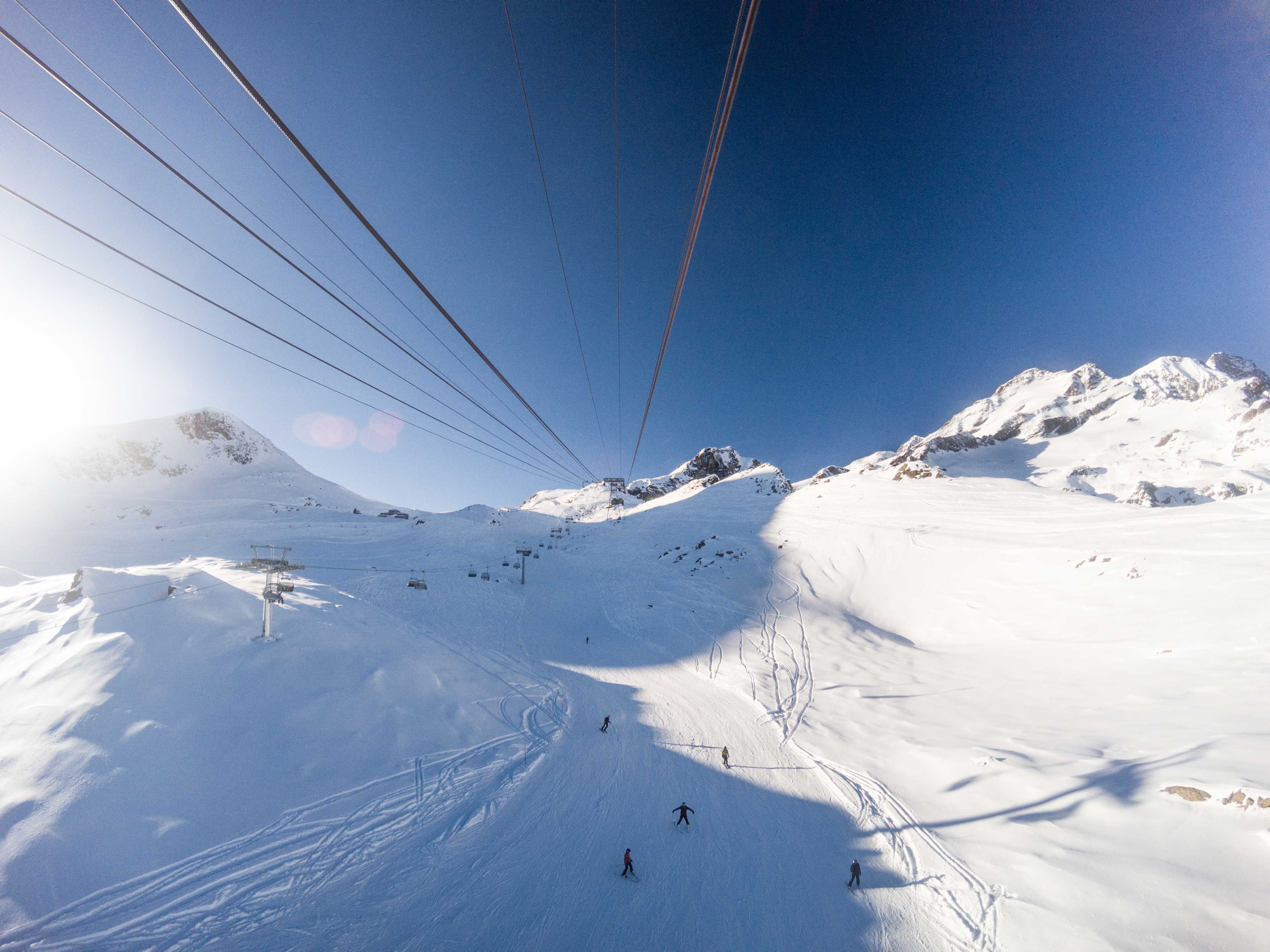
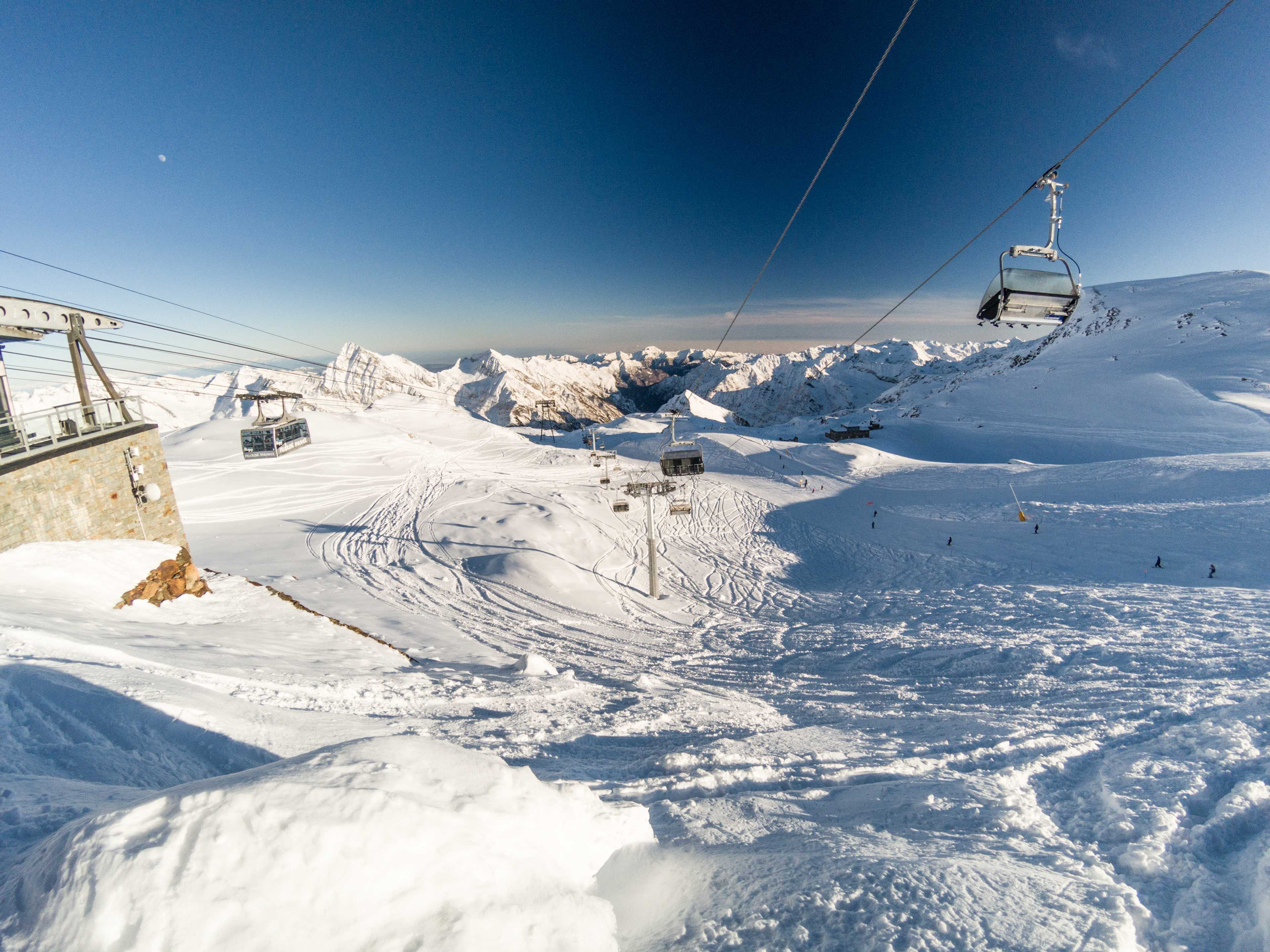
Punta Indren (3275 m a.s.l.).
If you decide to purchase a skipass, you have the option of paying a €2 daily surcharge for access to Passo Salati - Punta Indren (3275 m a.s.l.) - the highest point in the resort. If you don't decide on the extended ski pass, you can purchase a one-day admission for €5 - with unlimited ascents, of course. The purchase should be made at the ticket office at the bottom or at the top station of the gondola lift on Passo Salati.
Despite the warm encouragement from the lady at the ticket office, at the time of purchase I was not convinced that Punta Indren was the place for me. Later, out of curiosity, I only took advantage of the one-day admission, having prepared myself for the "mission". The upper station on Punta Indren is a place where there's absolutely nothing. Not even a restroom, bar or even ski slopes. There is one unprepared trail marked with poles from the top - shown on the map as a black dotted line. Nevertheless, quite a few skiers and snowboarders ascend to the summit. You can tell by their equipment that they are mostly people not looking for the marked trails ;).
Punta Indren is an ideal place to start your adventure with off-piste, freeride skiing. These types of activities are allowed in the Monterosa Ski area, and the resort's infrastructure makes it extremely easy and accessible. Of course, it's worth checking the predicted avalanche danger, the weather forecast and taking care of your equipment.
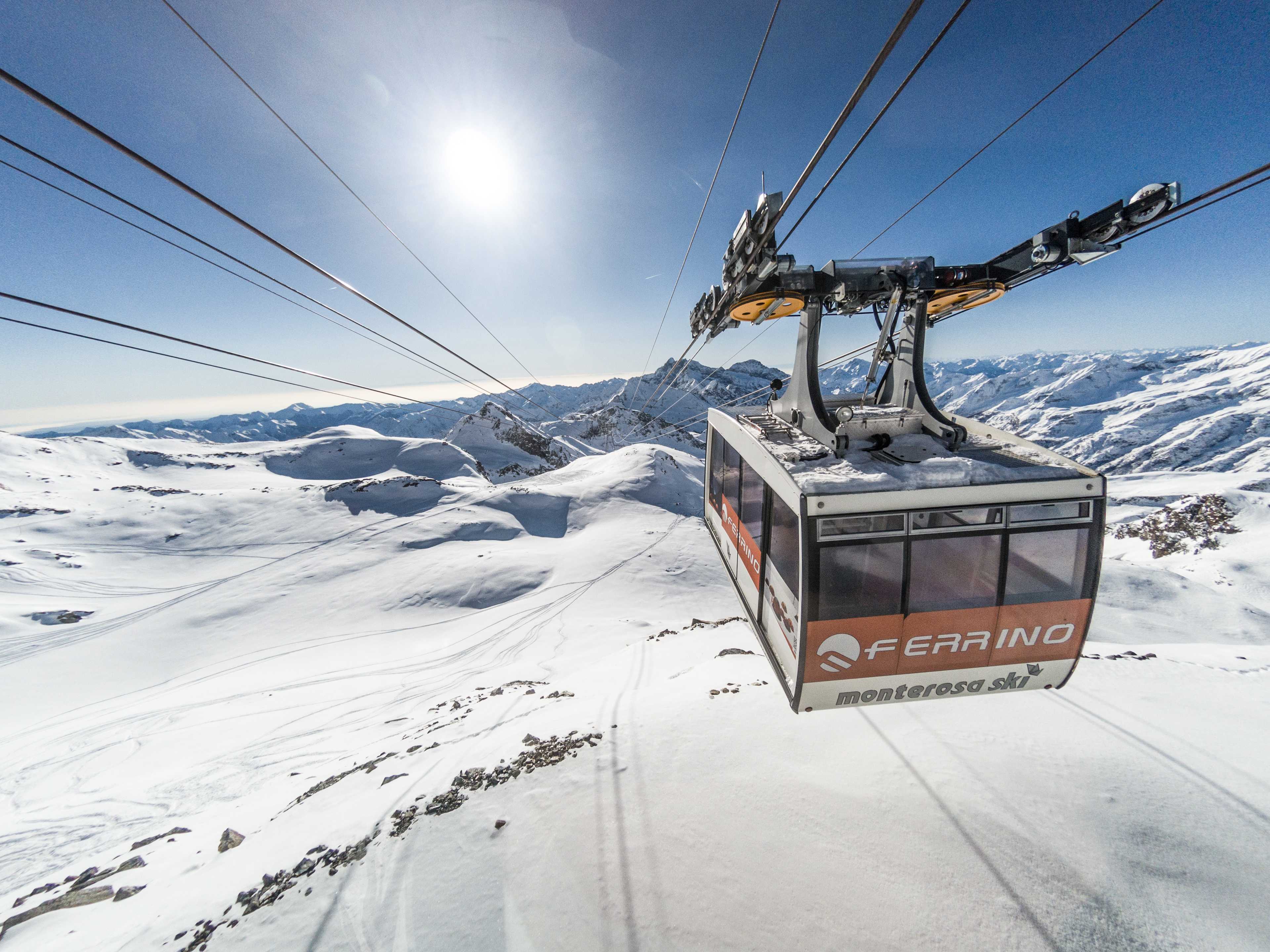
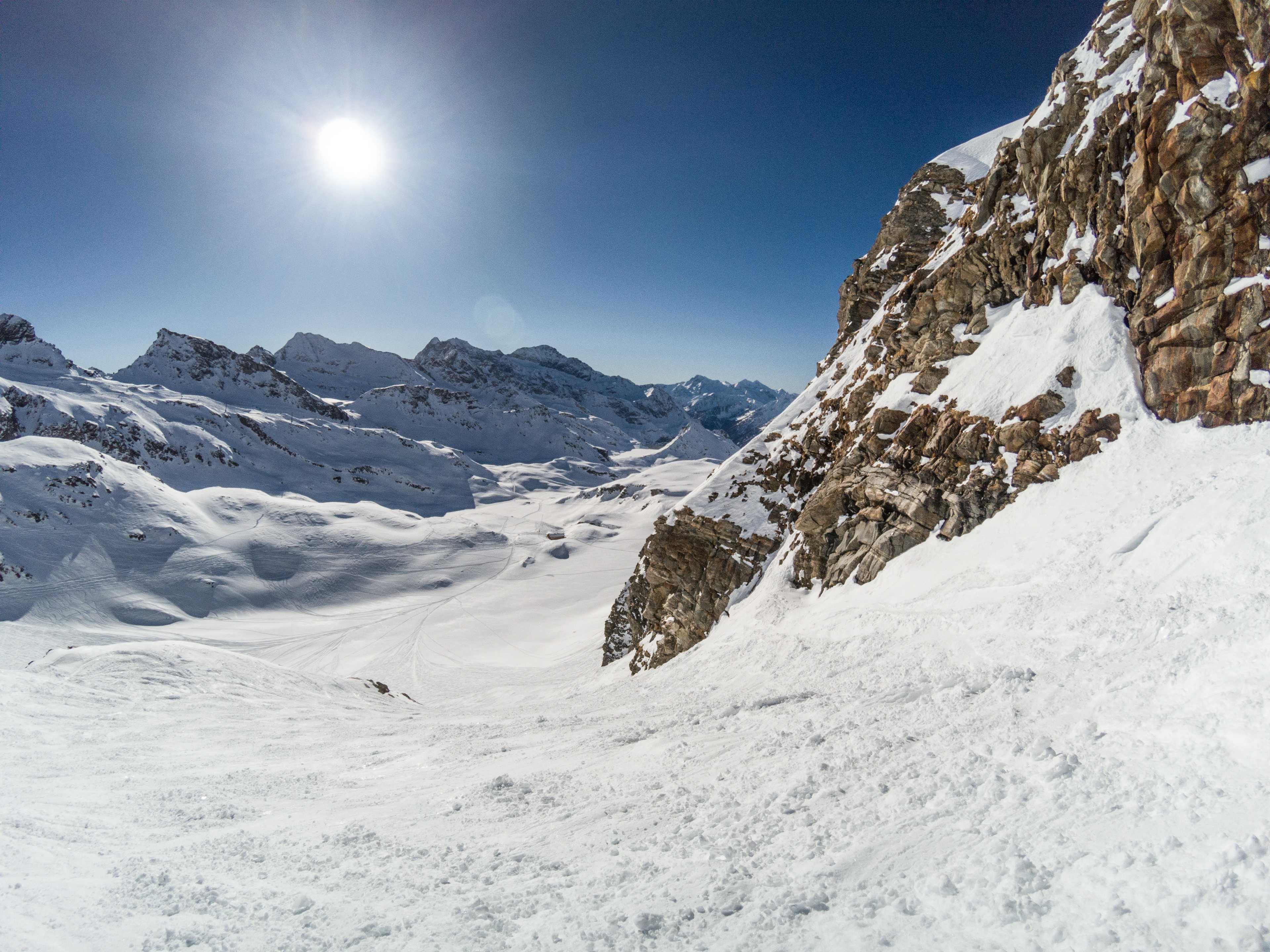
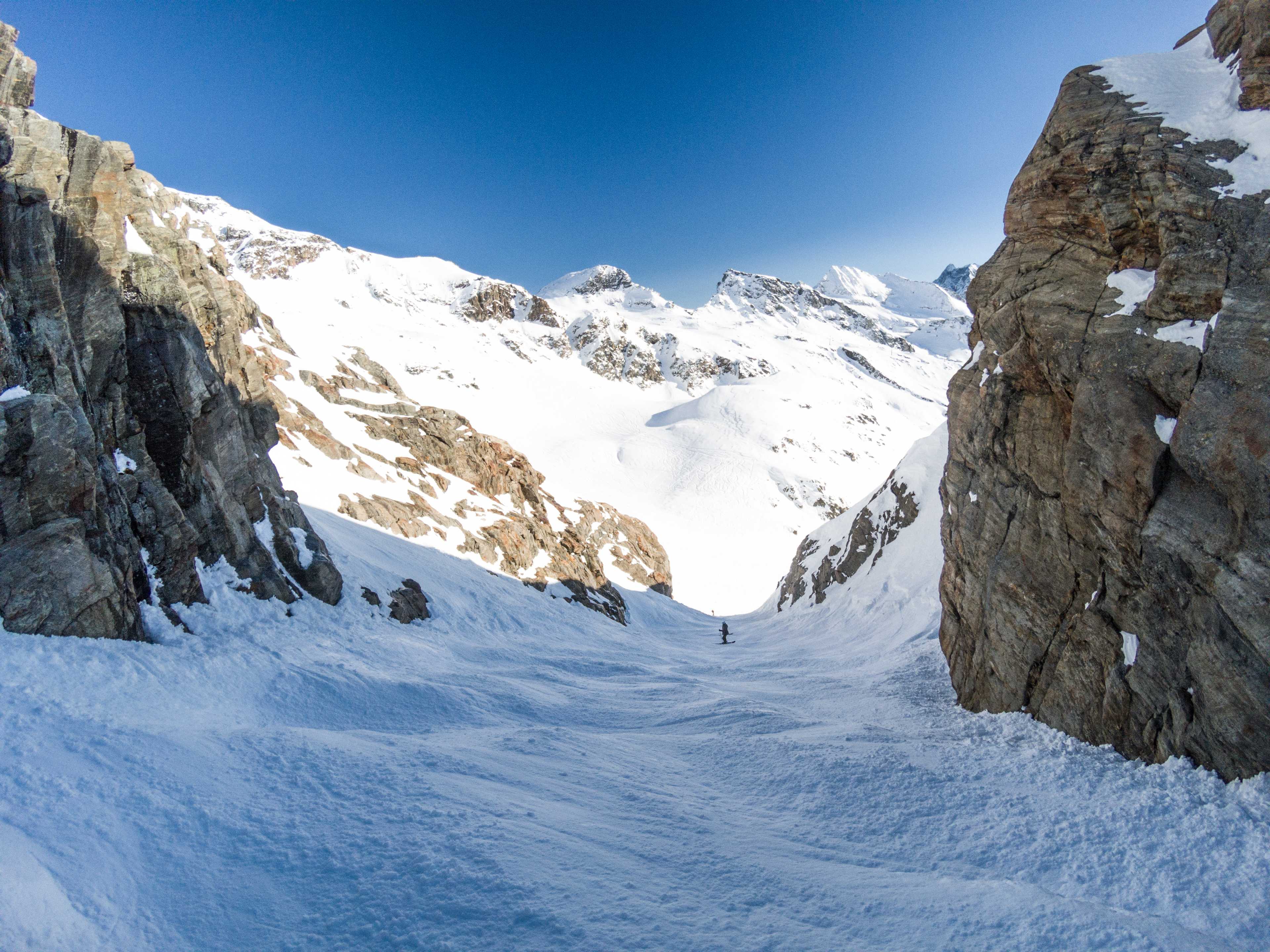
Freeride
In rental shops we will find all the necessary accessories for off-piste adventures. In addition to the appropriate skis or snowboard (which should be really soft and shaped for deeper snow), we are obliged to get a device commonly called "arva" (an acronym for the full name in Italian). The device, officially called an avalanche transceiver, is a simple tool that works in two modes and allows us to be located in the event of an avalanche or allows us to locate others nearby. The detector is legally required and random police checks reportedly occur off the slopes. In addition, we can rent a shovel, snow probe or even a backpack with an anti-avalanche airbag. The cost of renting skis with poles is €35 for one day. For a freeride kit, you pay €15 extra per day (the transceiver alone costs the same). Of course, with a rental of several days these prices drop. There are quite a few rental shops, I used the point in Gressoney, right at the lower station of the gondola lift.
Since the descent from Punta Indren to the west, towards Gabiet, is not very difficult, I decided to rent only a transceiver and proper skis together with poles. Hard RC4s and thin poles ending in small plates should definitely be left at home :). Upon entering the summit, I immediately observed that some of the more advanced freeriders headed east, towards Alagna. Others headed west, marked by poles. Since this area is extremely popular with off-piste enthusiasts, it was easy to tell by the tracks on the snow whether we were heading in the right direction. In the first steps taken off-piste, it is the traces that are the most important advisor, and I strongly recommend following as many of them as possible to begin with.
The descent begins with a huge, gentle plateau, where we freely choose our preferred path. The poles are visible practically all the time. Of course, it is worth being cautious, because contrary to first impressions, deep snow can be quite fast. In places we will meet rocks and stones, so it is worth watching the tracks of other skiers. After the first kilometer we reach a fork, where we have the "official" path (on the left) and a variant between the rocks on the right. The one on the left seems to be narrower and steeper.
Both are a real eye candy, where we can feel like nowhere else on-piste. The proximity of the rocks, the lack of ubiquitous skiers and the vast amounts of snow all the way to the horizon are spectacularly impressive.
At the foot of the rocks (regardless of the chosen variant), a narrower trail begins across the snow desert, which at some point will bring us to a place where we may feel disoriented. The poles marking the trail begin to lead uphill (they are along a marked mountain road). However, the traces indicate that skiers prefer to take a different route. It quickly turns out that this is a good choice and there is no need to go up anywhere. A kilometer further on, we see in the distance the gondola stations to and from Gabiet. More advanced skiers, judging by the tracks, go lower down to the forested part of the area - there you can get all the way to Stafal. The less skilled should rather opt to return to the "civilized" part of the resort.
The first descent tired me out a lot, but I also definitely enjoyed it and quickly started to want more. From Punta Indren I descended three more times, deciding to deviate more and more from the trail. In addition, along the Gabiet-Passo Salati gondola, we also have a huge freeride area, perfect for a start, which we use to descend to the bottom of the descent from Punta Indren. If you look around, the terrain around Passo Salati, on both sides of the ridge, is ideal for off-piste skiing, confirmed by the snow traces. Also on the side of the black route to Pianalunga, towards Alagna, we can enjoy a very steep and wide slope at the foot of the rocks that crown Cimalegna.
So who is freeride for? If you are not afraid of heights, like a bit of adrenaline, and are very good at skiing on groomed slopes, then there is no reason against trying this kind of skiing. It certainly costs more energy and requires skills.
Is freeride tough? Not as much as it might first seem. If you can handle black, steep runs and are able to tackle uneven slopes full of moguls - there should be no problem. The key is the right equipment, because on classic or slalom skis it will definitely be tricky, if not to say impossible.
Is freeride dangerous? In the case of Monterosa, not much more so than skiing on pistes. Therefore, it is a suitable place for people who would like to start their adventure with off-piste skiing. The hazards are certainly the rocks (and therefore we must have full control) and avalanches (especially in the parts above Punta Indren, where we can get there on foot or by helicopter). With the use of common sense and checking the weather forecast (extremely important in the mountains anyway), the risk goes down to a minimum.
For those who are afraid to try their hand on their own, there are also specialized off-piste ski schools in Gressoney and Alagna, which offer lessons and off-piste excursions. Their price depends on the size of the organized group and the type of expedition. For about €300-400 per day, we can already try our luck at so-called heliskiing, which is extremely popular in this region. A helicopter will carry us up to an altitude of even more than 4,000 meters to the glaciers in the Breithorn and Monterosa massifs. In this type of excurions, we receive, of course, in the price the appropriate equipment (including backpacks with airbags or transceivers).
Infrastructure
This is definitely not the resort's strongest point. The most development in recent years has taken place in the eastern part of the resort. These are the two very fast funifor cable cars (on Passo Salati and on Punta Indren), which have two large cars that move independently on separate cables. The modern chairlift leading over Passo Salati, completed in the 2017/2018 season, seems to confirm that this part of Monterosa Ski is now the focus of modernization.
Unfortunately, you'll find a lot of obsolete structures at the resort - it's not uncommon to move on a free, two-person chairlift, and the central Champoluc point is just a one huge queue for a slow (although detachable) quad chairlift.
If the connection to Cervinia, which has been rumored since 2014, is to come to fruition, changes are definitely needed at Monterosa Ski - particularly in the Colle Bettaforca massif and Champoluc area. We're mainly talking about the aging cable car from Stafal, the aforementioned Alpe Mandria lift or double lifts connecting to Frachey.
Nevertheless, it is worth mentioning that during the high winter season in the resort there were basically no queues to the lifts (except for Alpe Mandria) or they were absolutely unobtrusive. This is very good news, because for this reason, among others, I am very eager to return to this resort again this winter.
On the other hand, one of the resort strong points are the gastronomic outlets present practically everywhere - bars and restaurants. Due to the considerable cultural diversity, in the three valleys we will eat truly delicious specialties of local cuisines (including amazing cheeses and cured hams), and those who want to dine in a short period of time will certainly enjoy excellent hot sandwiches (panini).
Stations in the valleys are accompanied by huge, free parking lots, which can easily accommodate for the moment, vehicles of all the ski fans. Skipasses can be bought at ticket offices, where staff speak English, German, French and, of course, Italian. A minor inconvenience is the inability to get back the deposit (€5) for the skipass card after 5 pm, at which time the cash offices close. It's strange that the resort hasn't decided to install terminals for returning the card itself. However, if the card is not being handed back and you plan to return to the resort during the same season, the skipass can be added to the card online by paying online at the Monterosa Ski website.
Summary
Monterosa Ski is a very high-altitude resort that offers one of the largest elevation differences in Europe. It's also a mecca for off-piste skiing, for which the resort is perfectly prepared. Due to its location, it's not a popular choice among tourists, with skiers from the area around nearby Milan or Turin predominating. The slightly outdated infrastructure doesn't seem to bother us at all, and we won't encounter crowds on the slopes of the complex. Instead, we can enjoy the proximity of nature and beautiful landscapes. Monterosa Ski is an unusual place and offers excellent conditions from December until April.
Typical season prices:.
- one-day skipass 40-48 €.
- one-week skipass 246-272 €.
- surcharge 2 € / day for admission to Punta Indren.
- a meal on the slope 5-15 €.
- a night in a typical guesthouse or hotel € 80-200.
The resort is ideal for: freeride enthusiasts and intermediate and advanced skiers.
The advantages of the resort:.
- excellent conditions for both on and off-piste skiing.
- more than 100 km of ski runs
- beautiful, unparalleled views
- infrastructure providing the opportunity to practice heliskiing and freeriding.
Disadvantages of the resort:.
- outdated infrastructure in places.
- few places for less advanced skiers
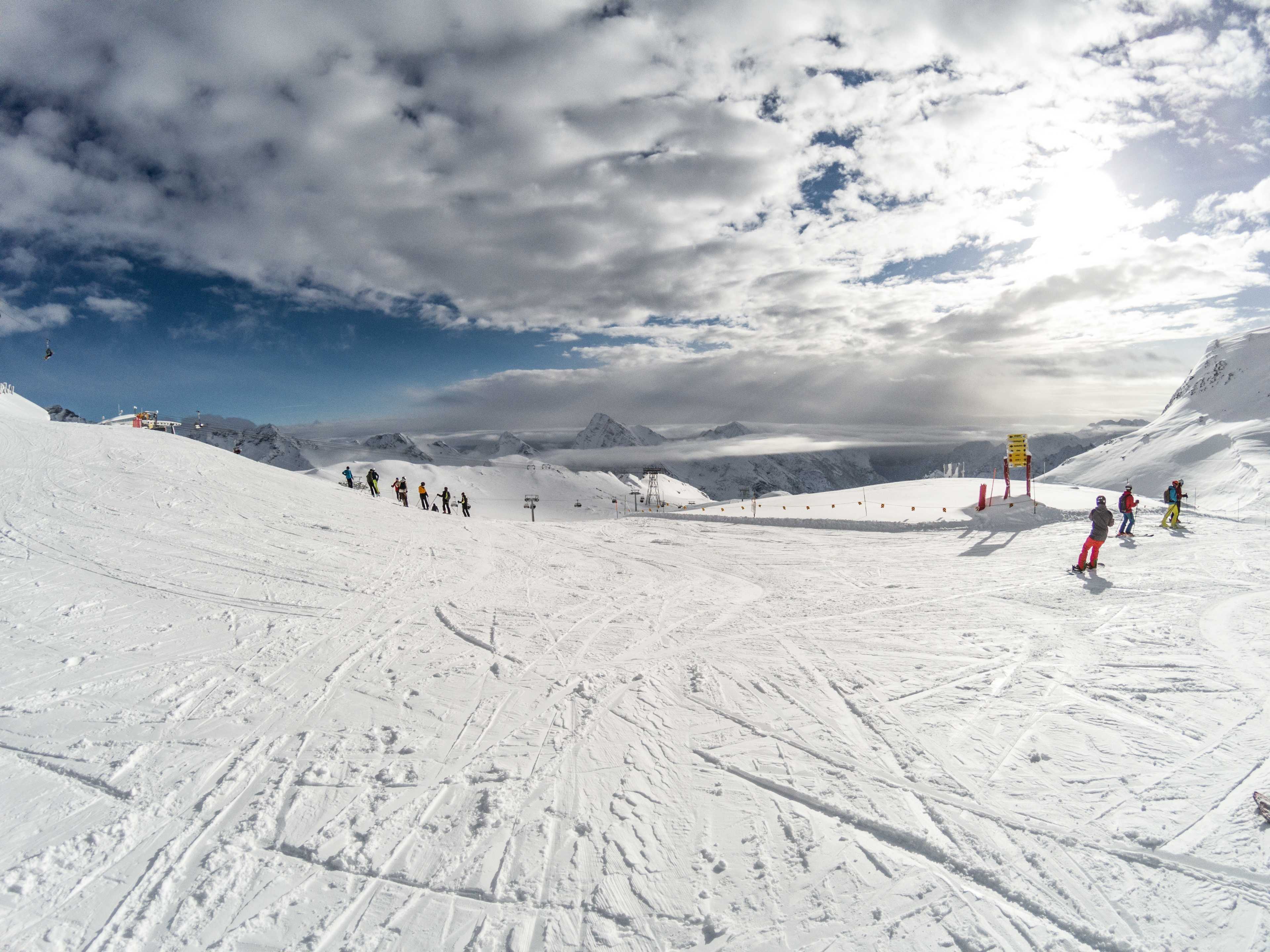
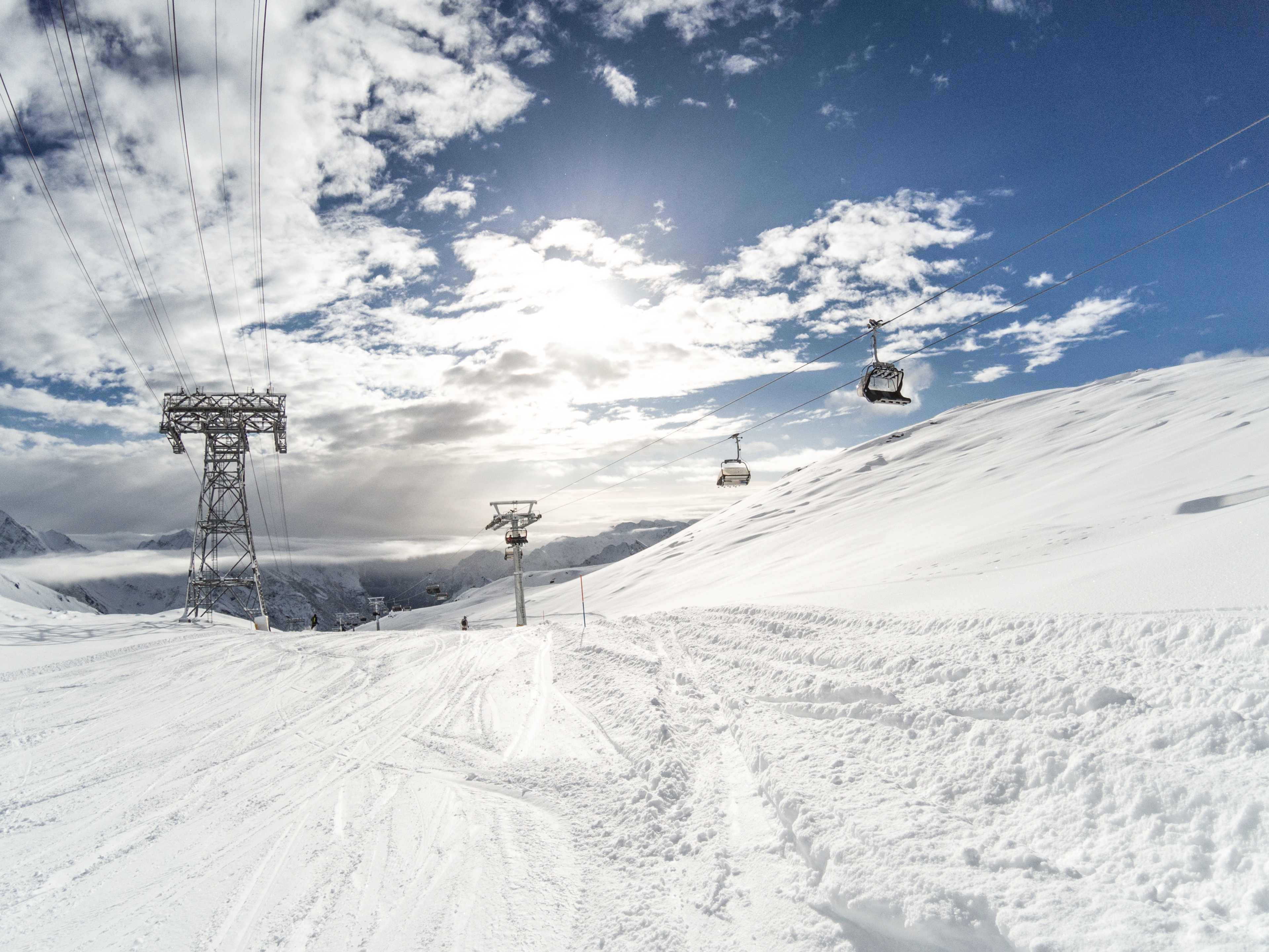
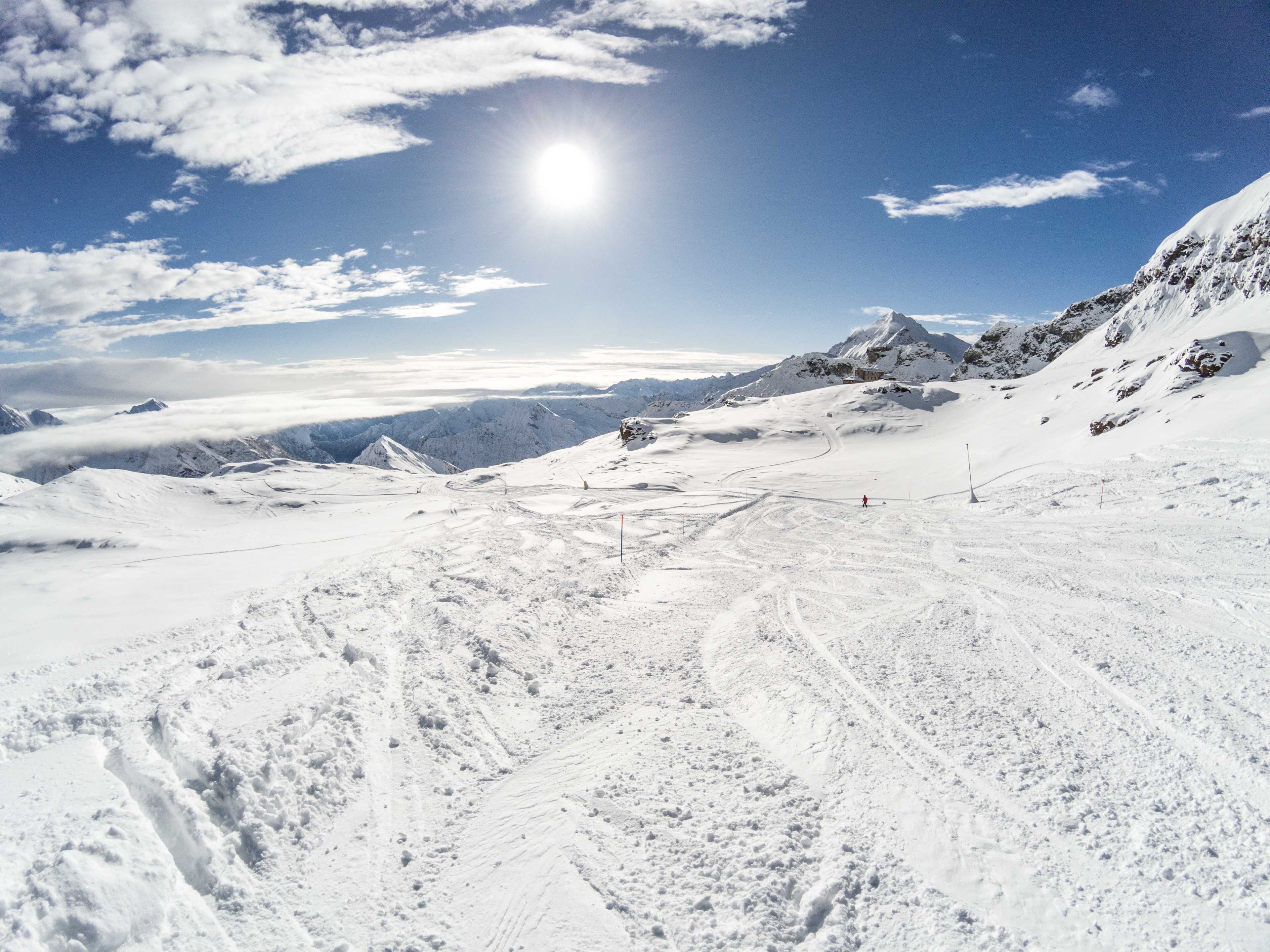
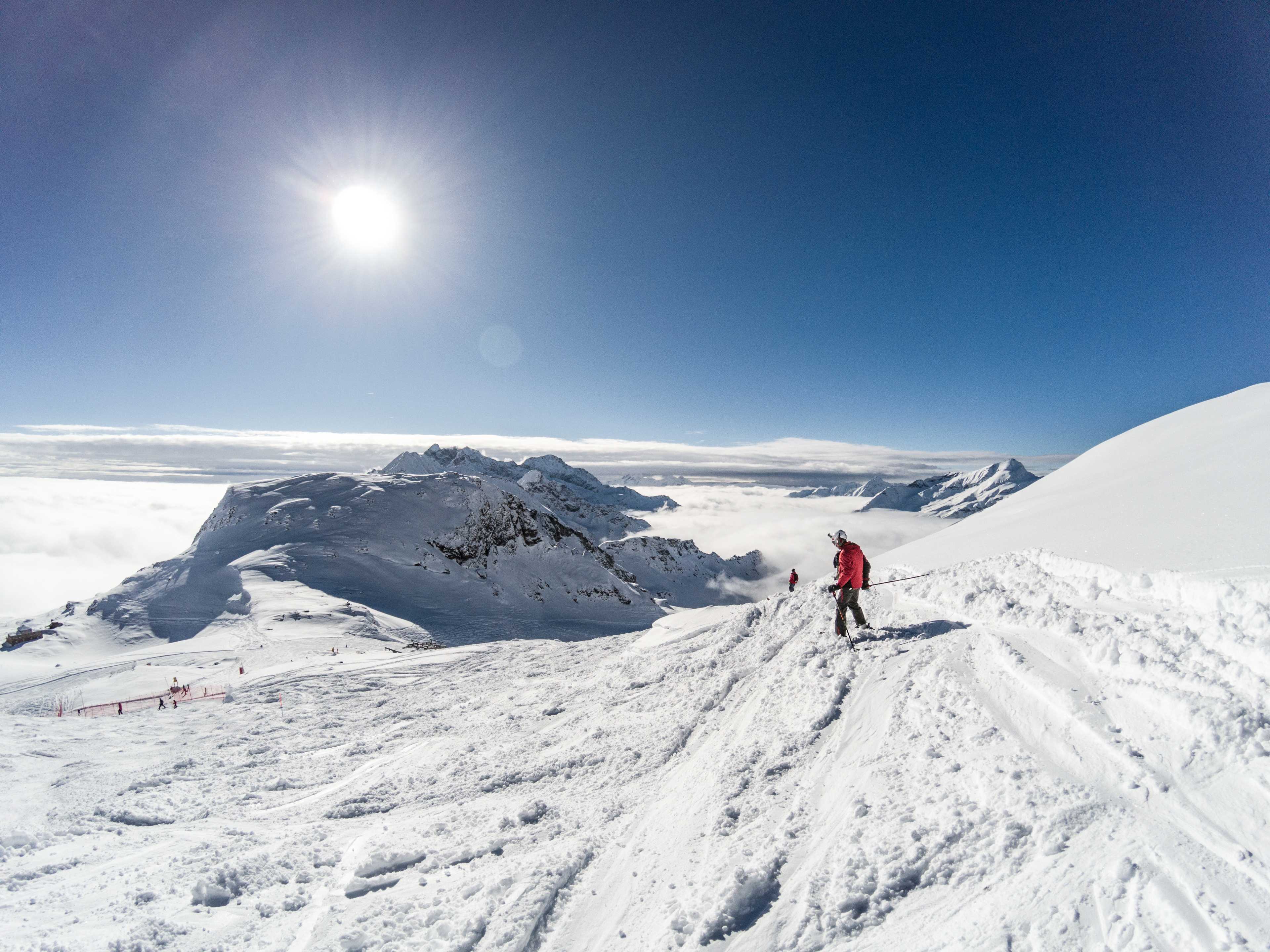
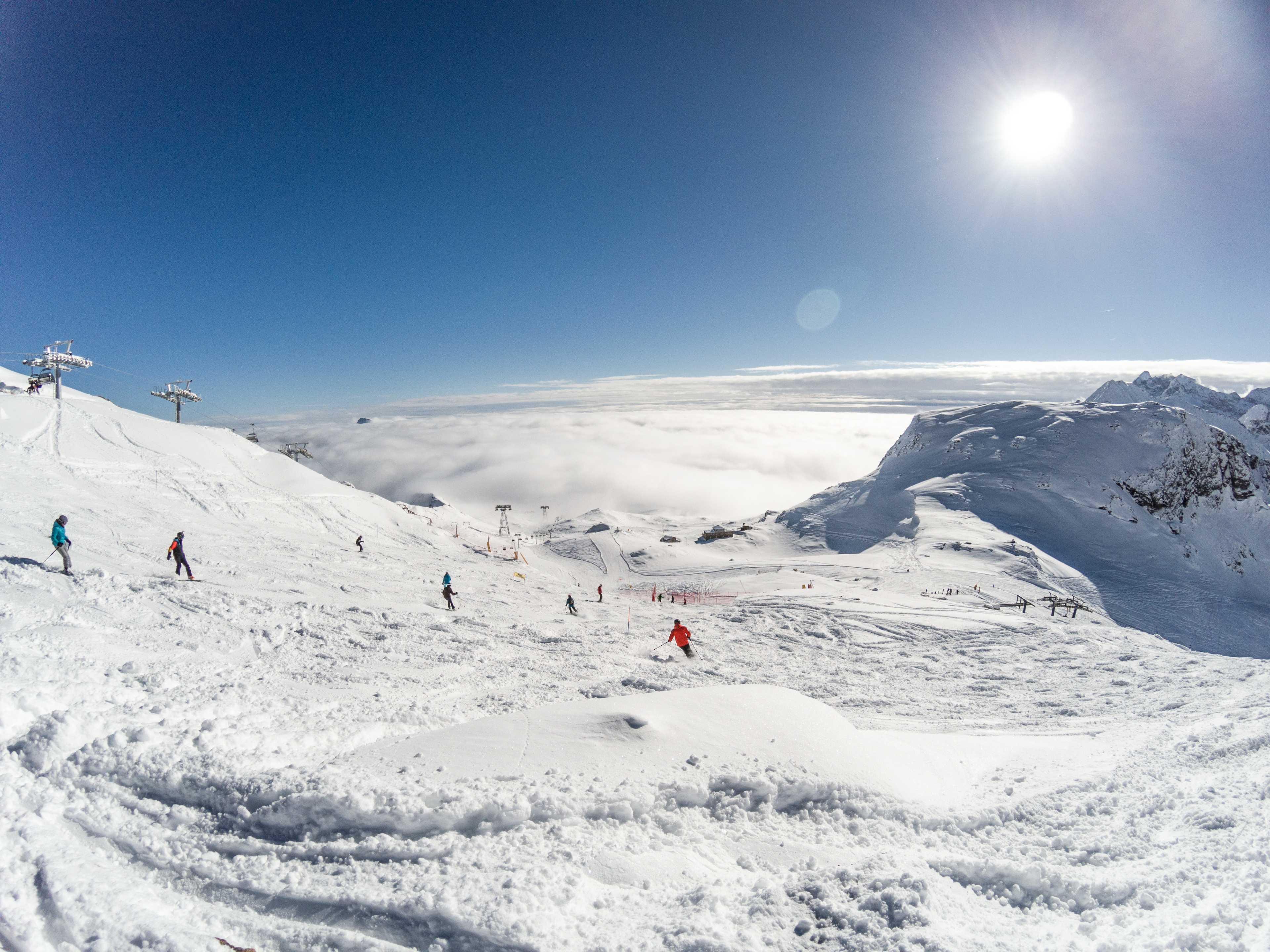
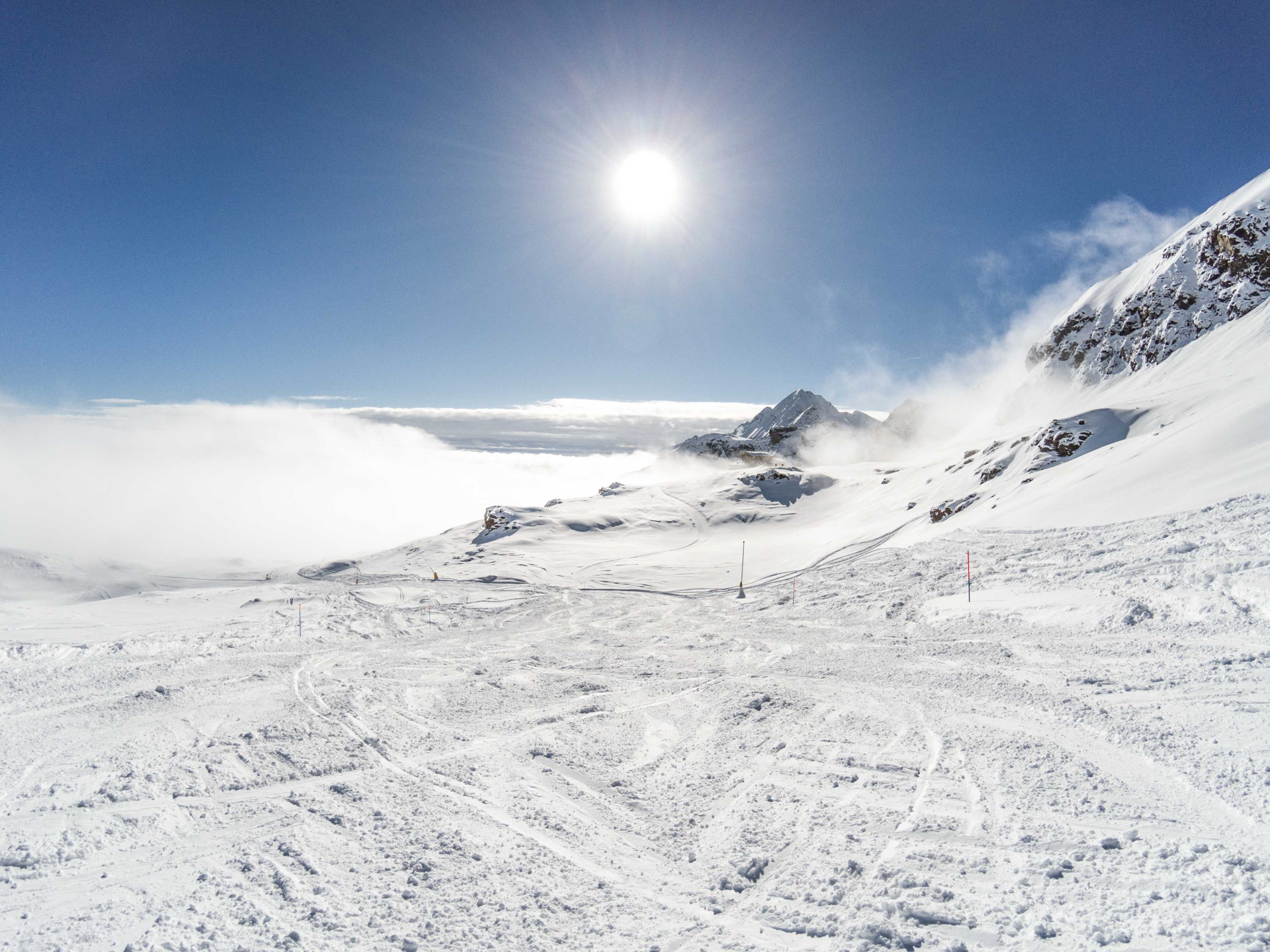
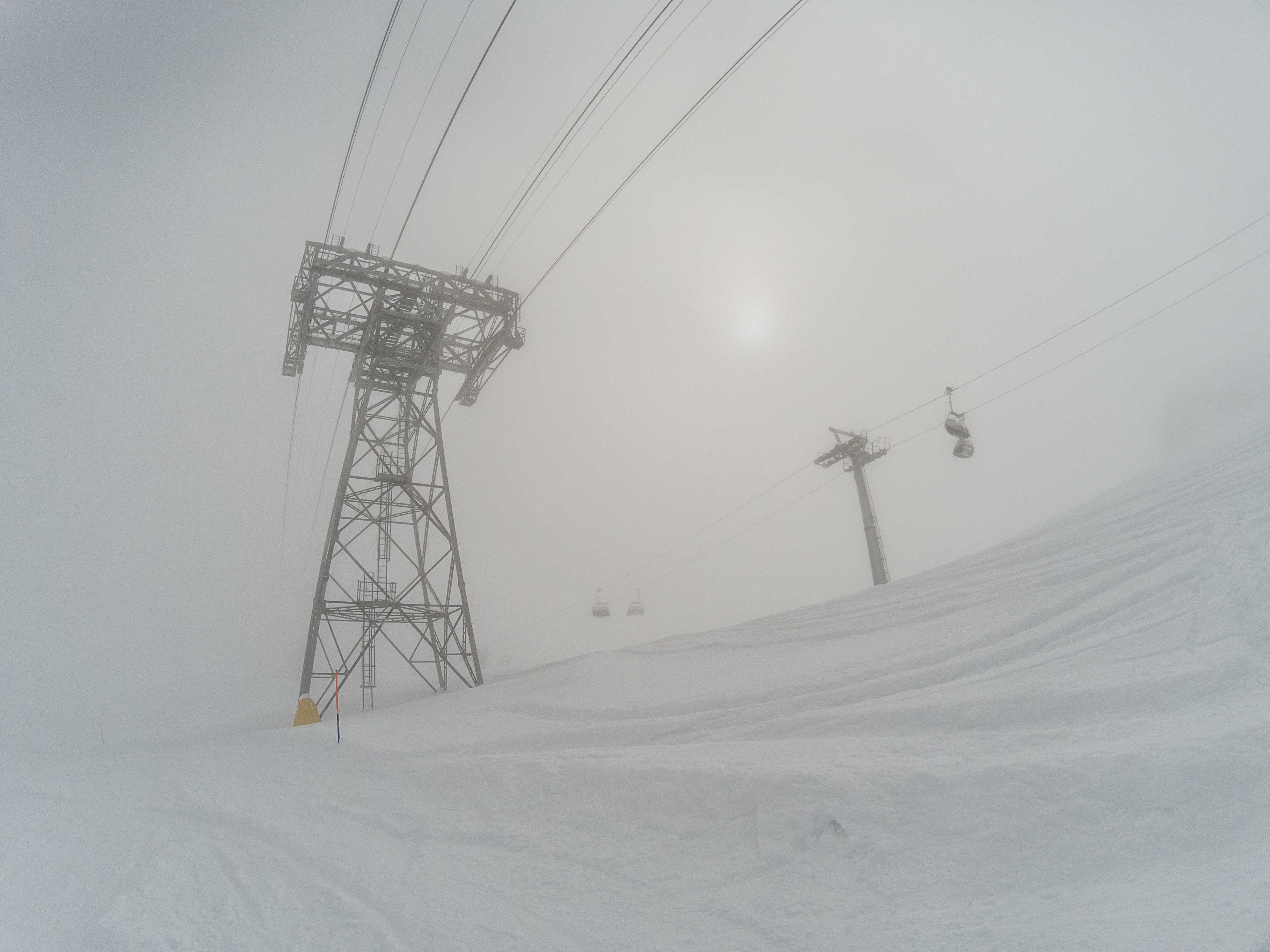
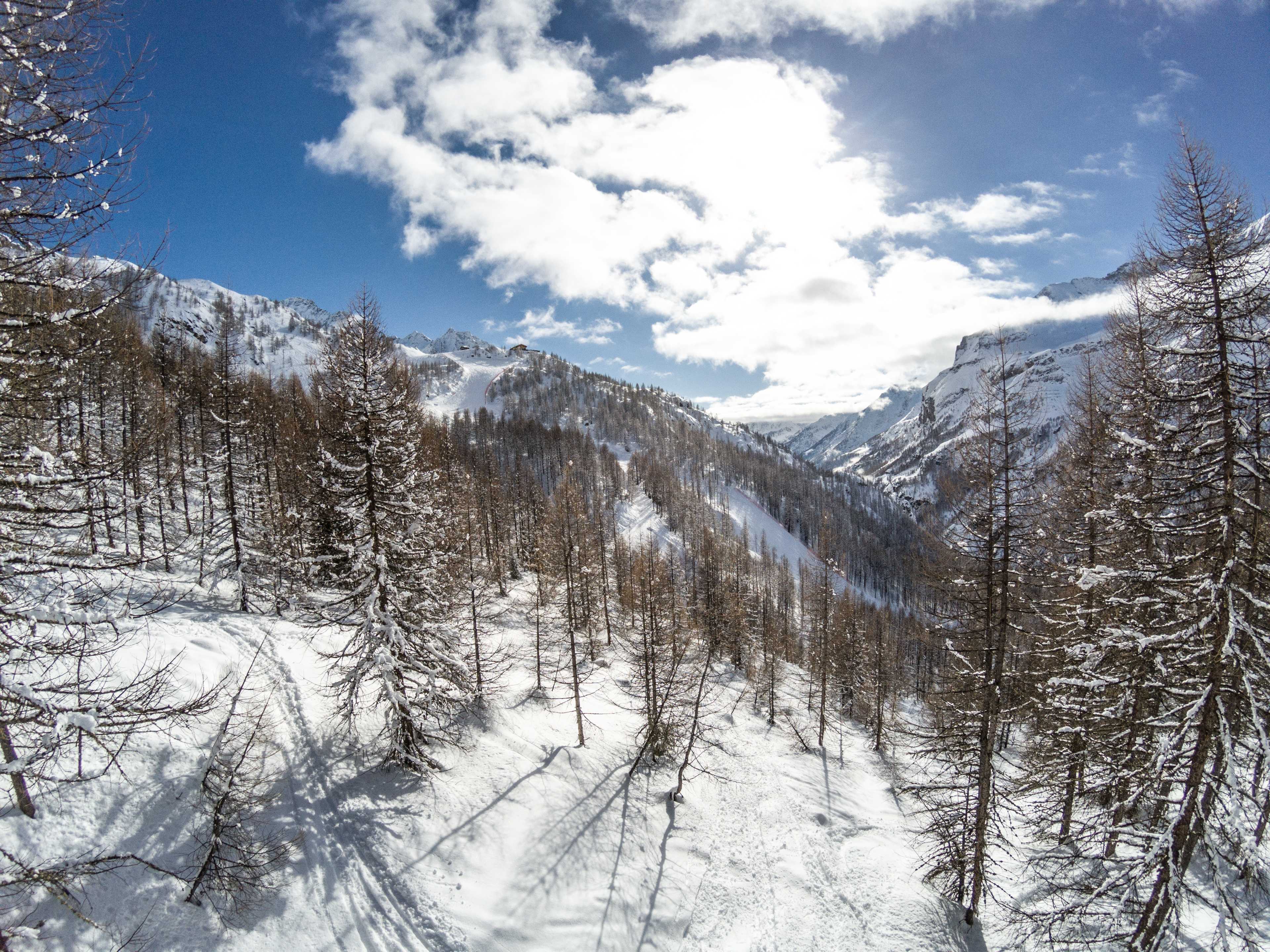
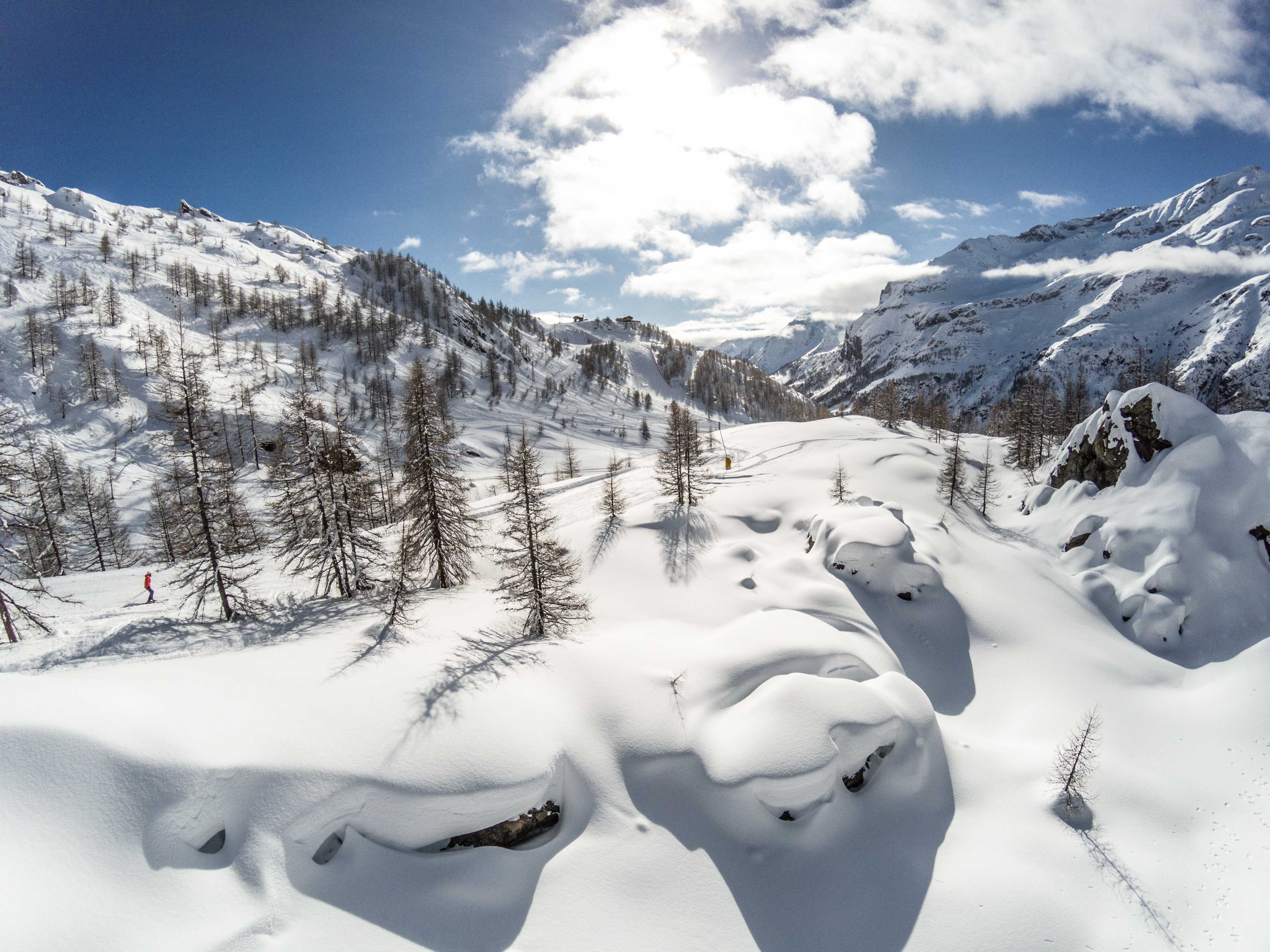
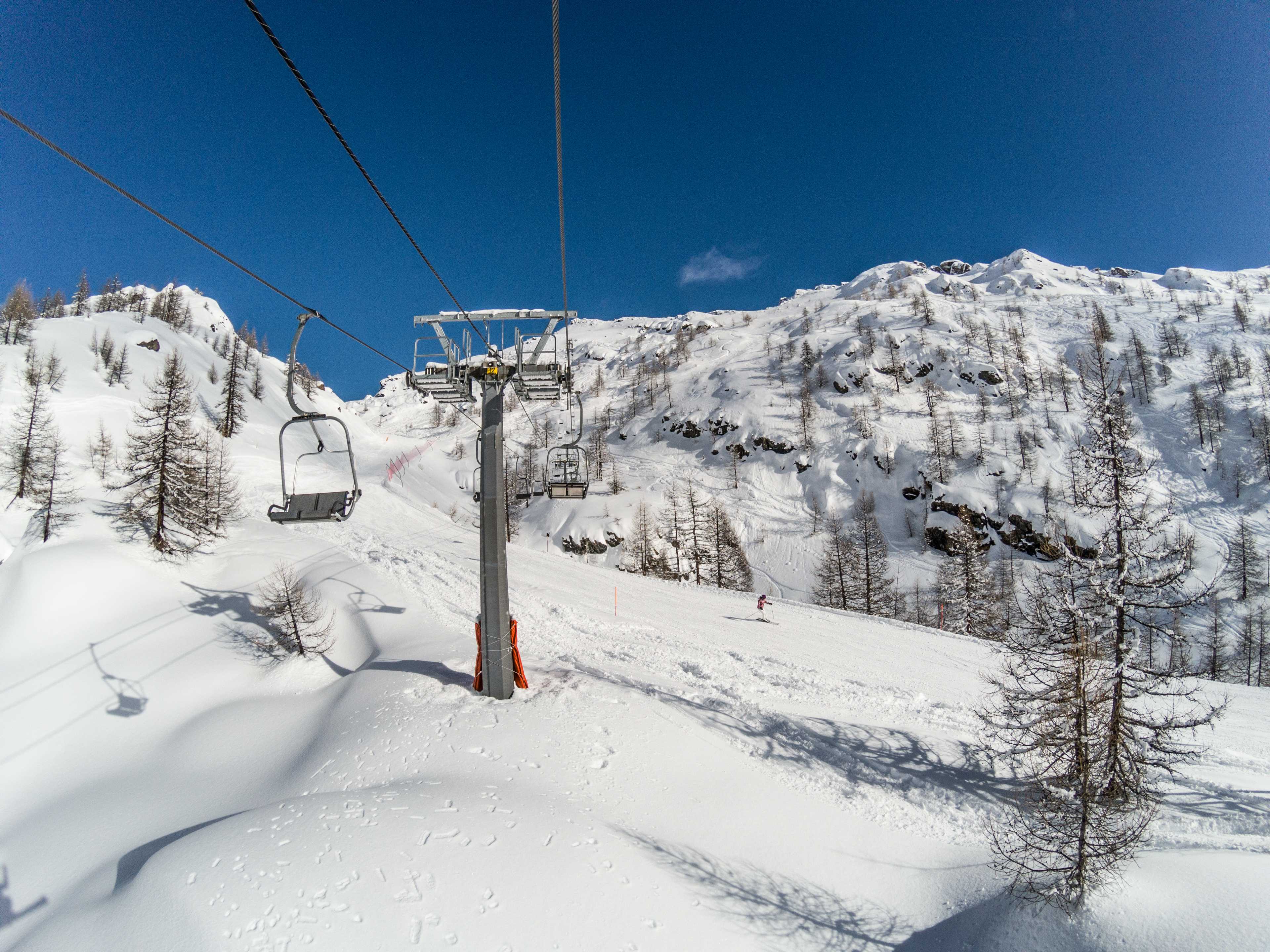
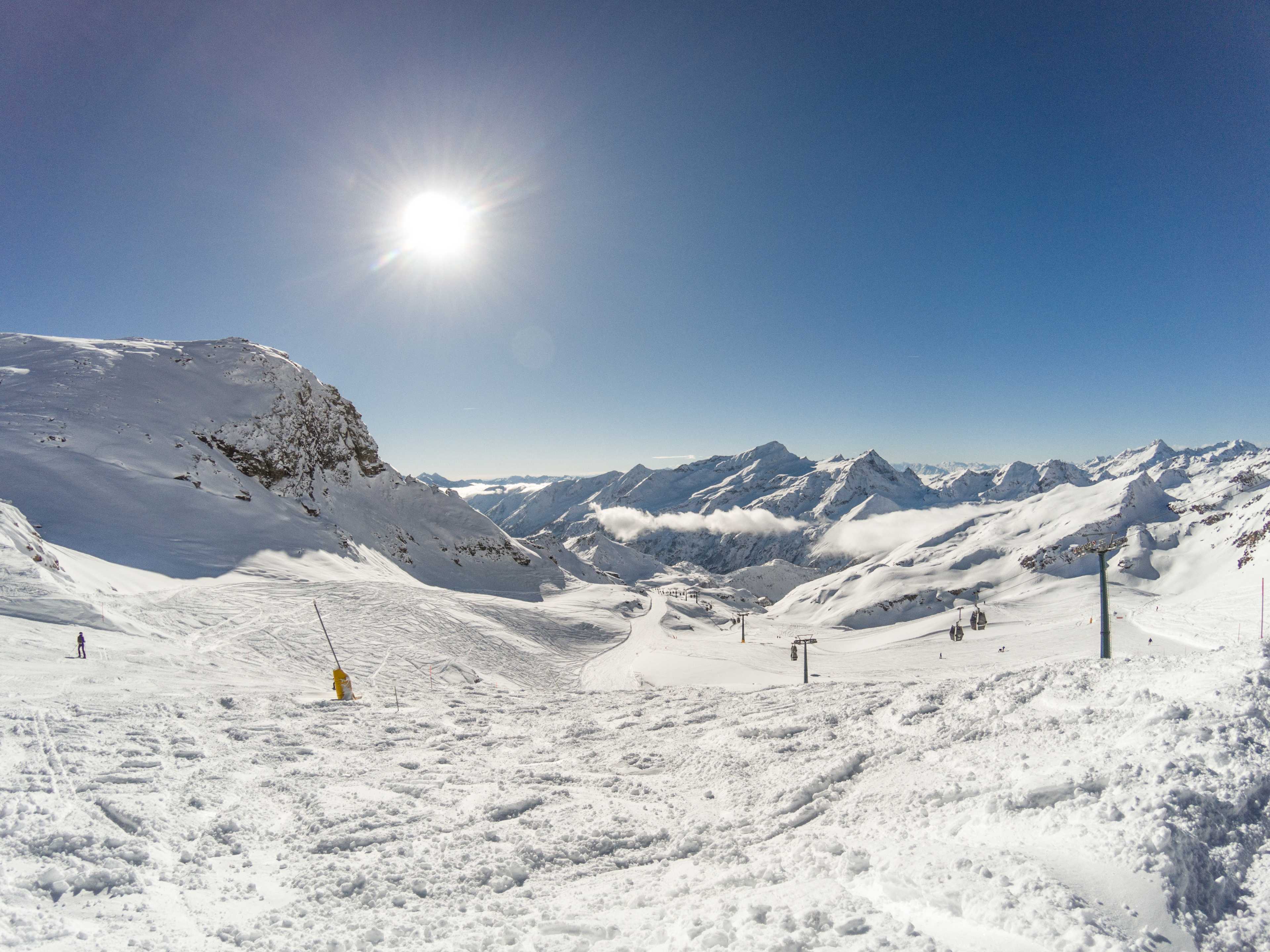
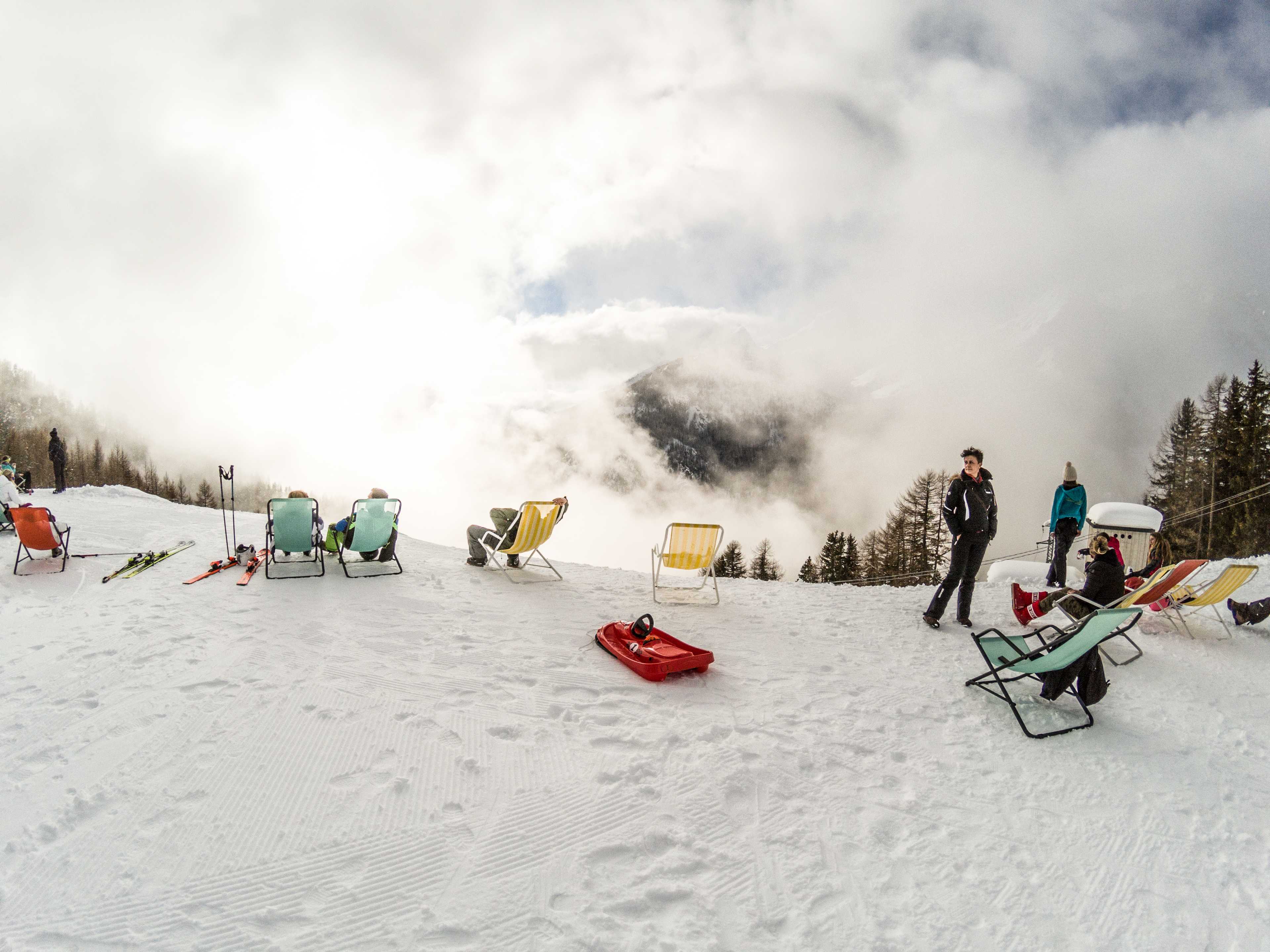
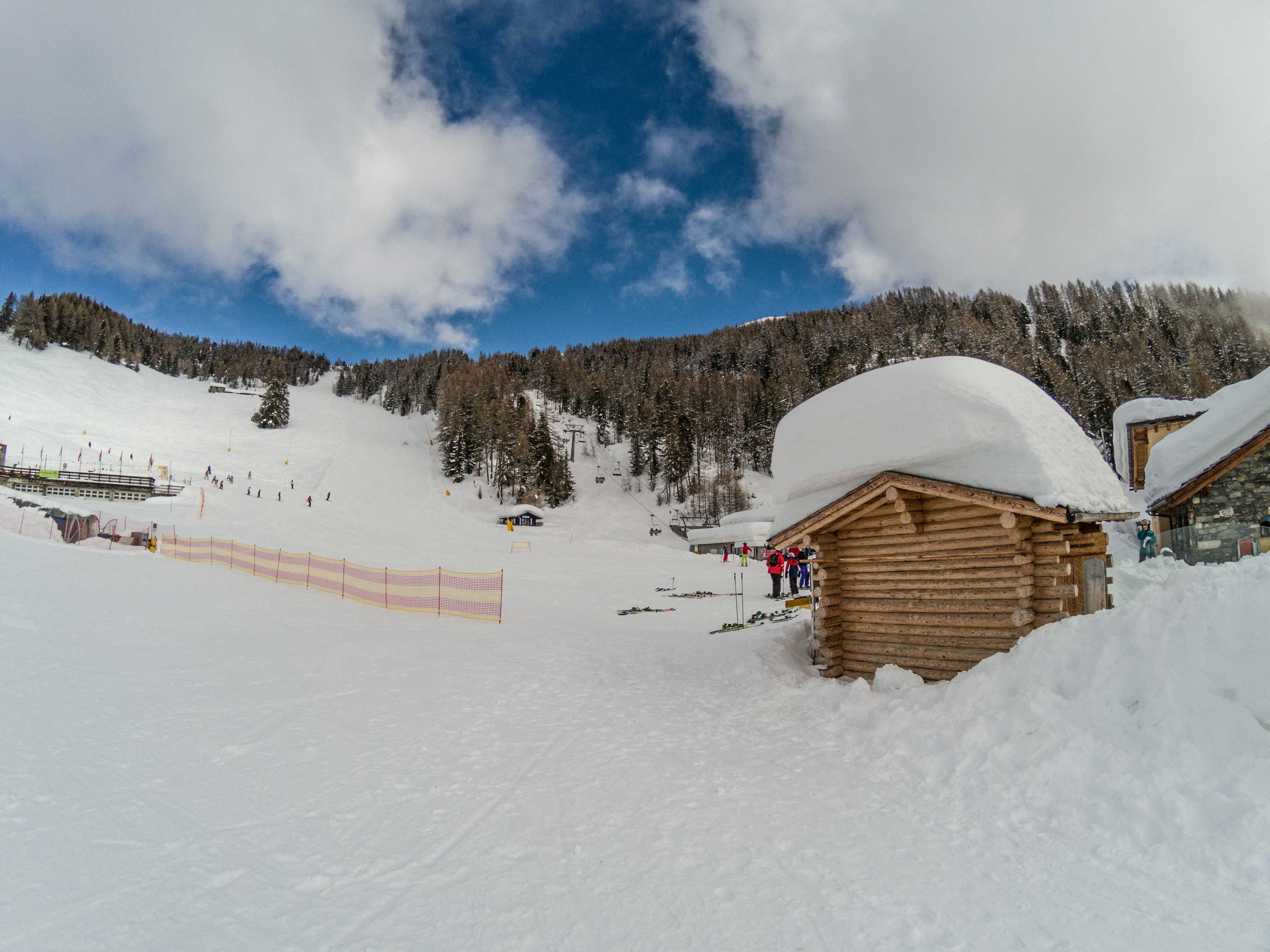
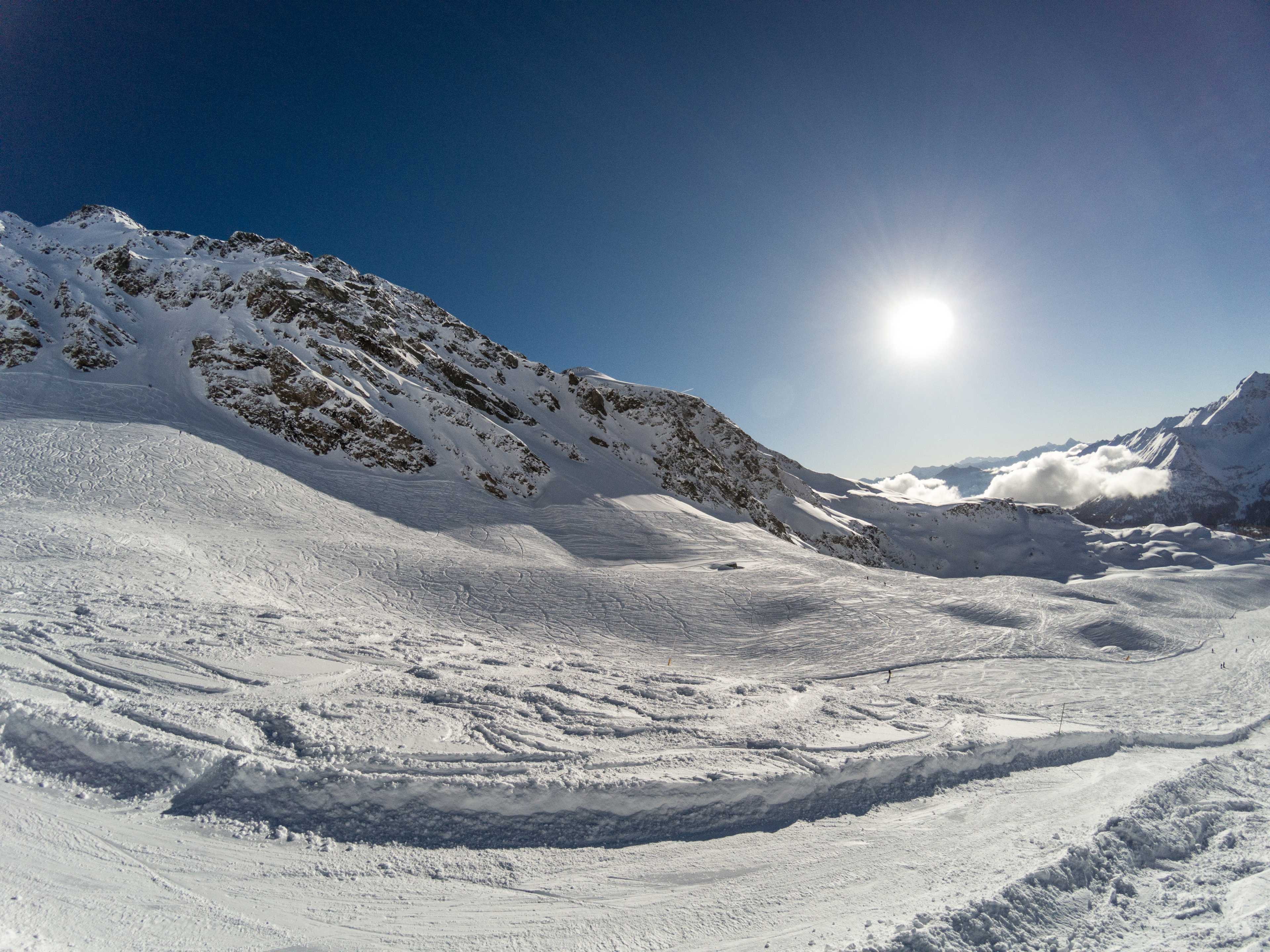
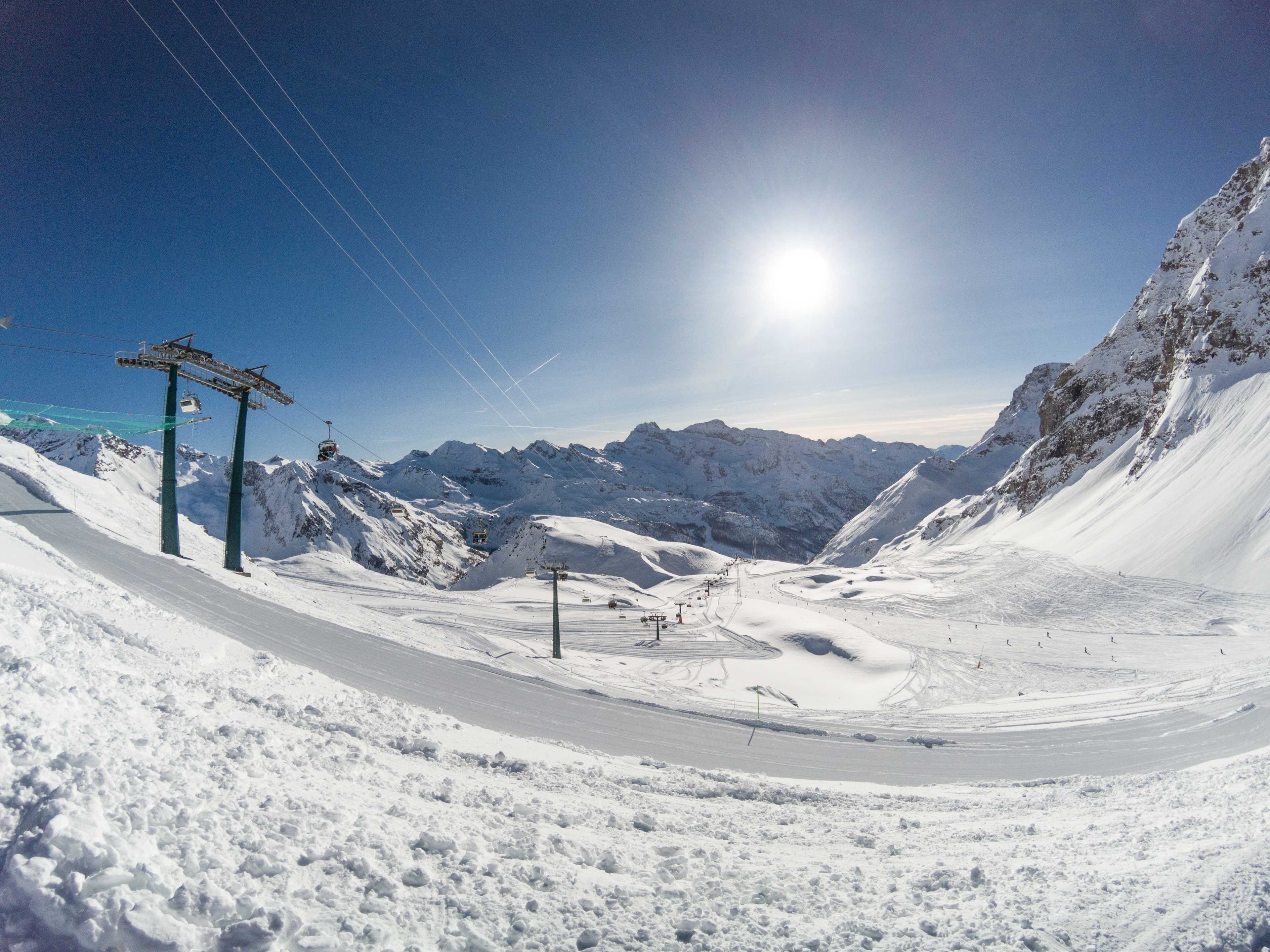
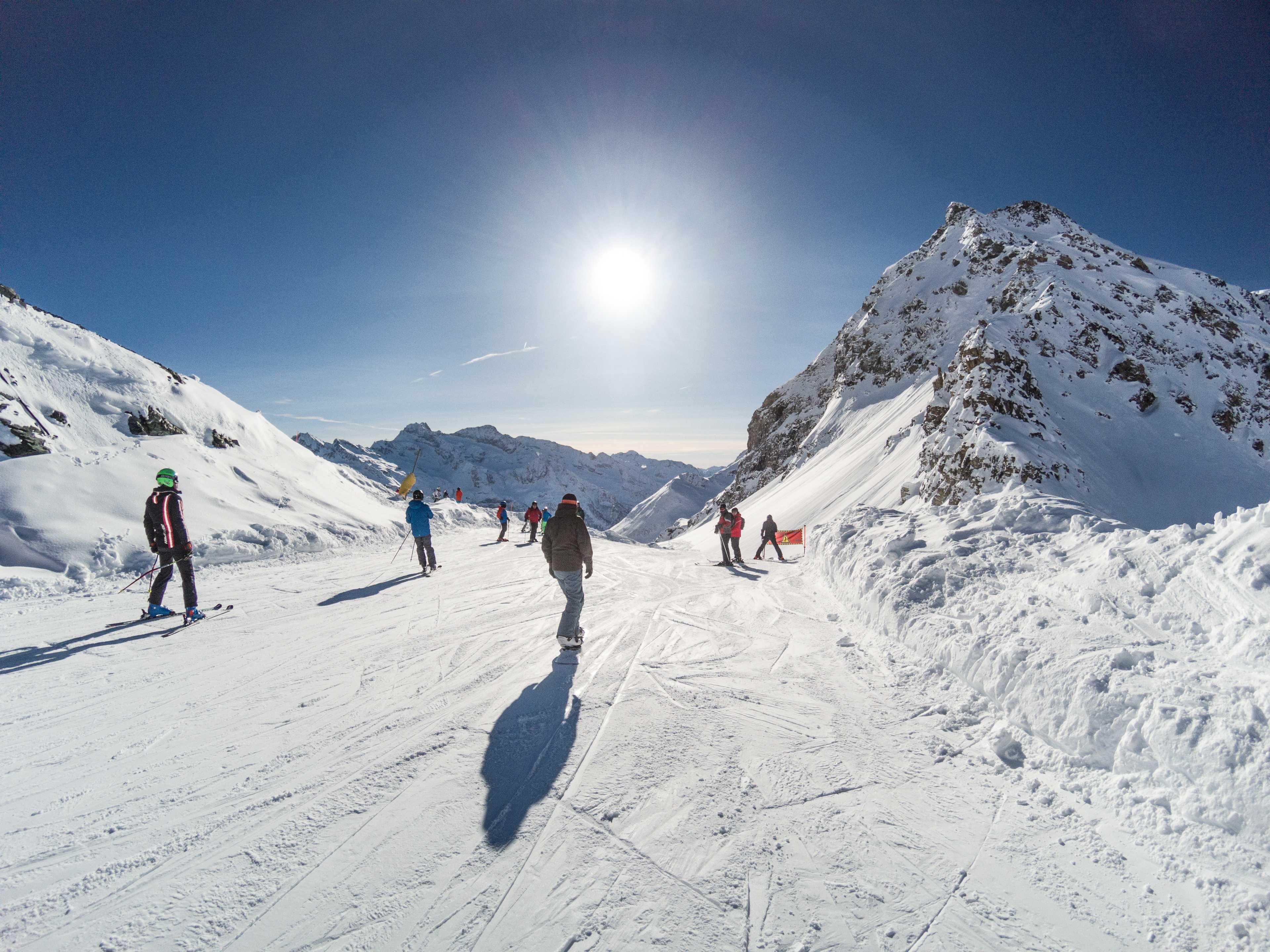
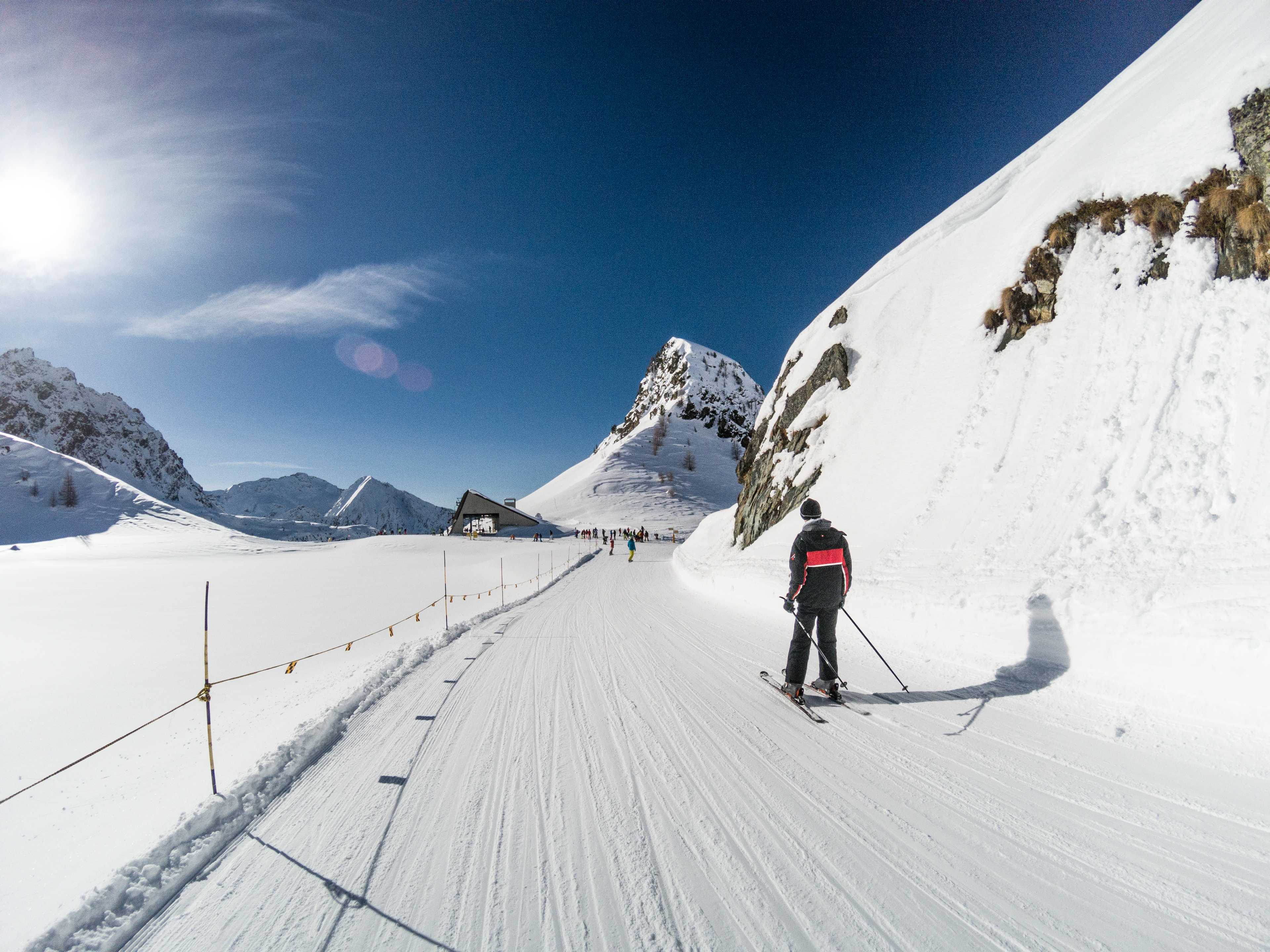
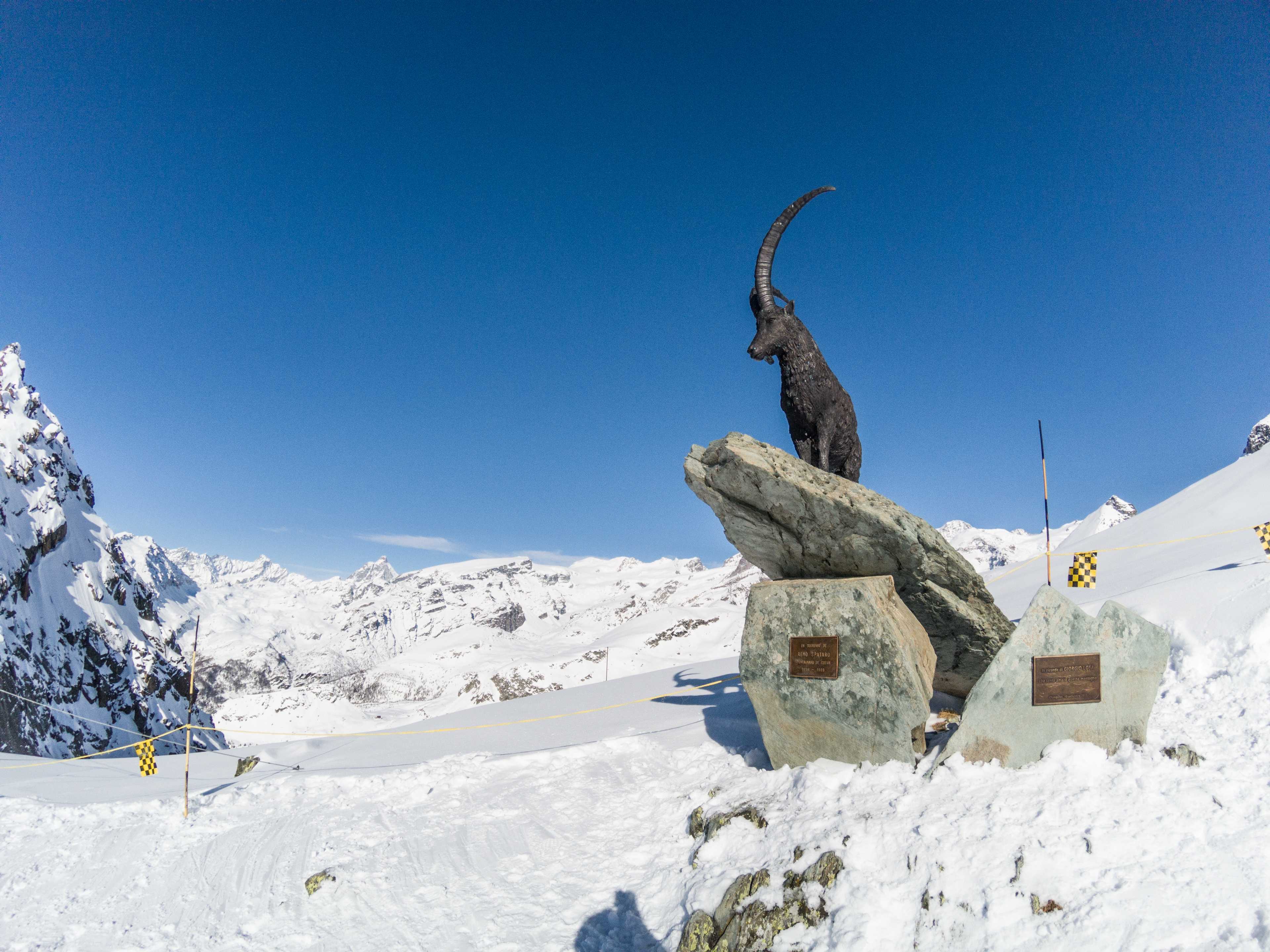
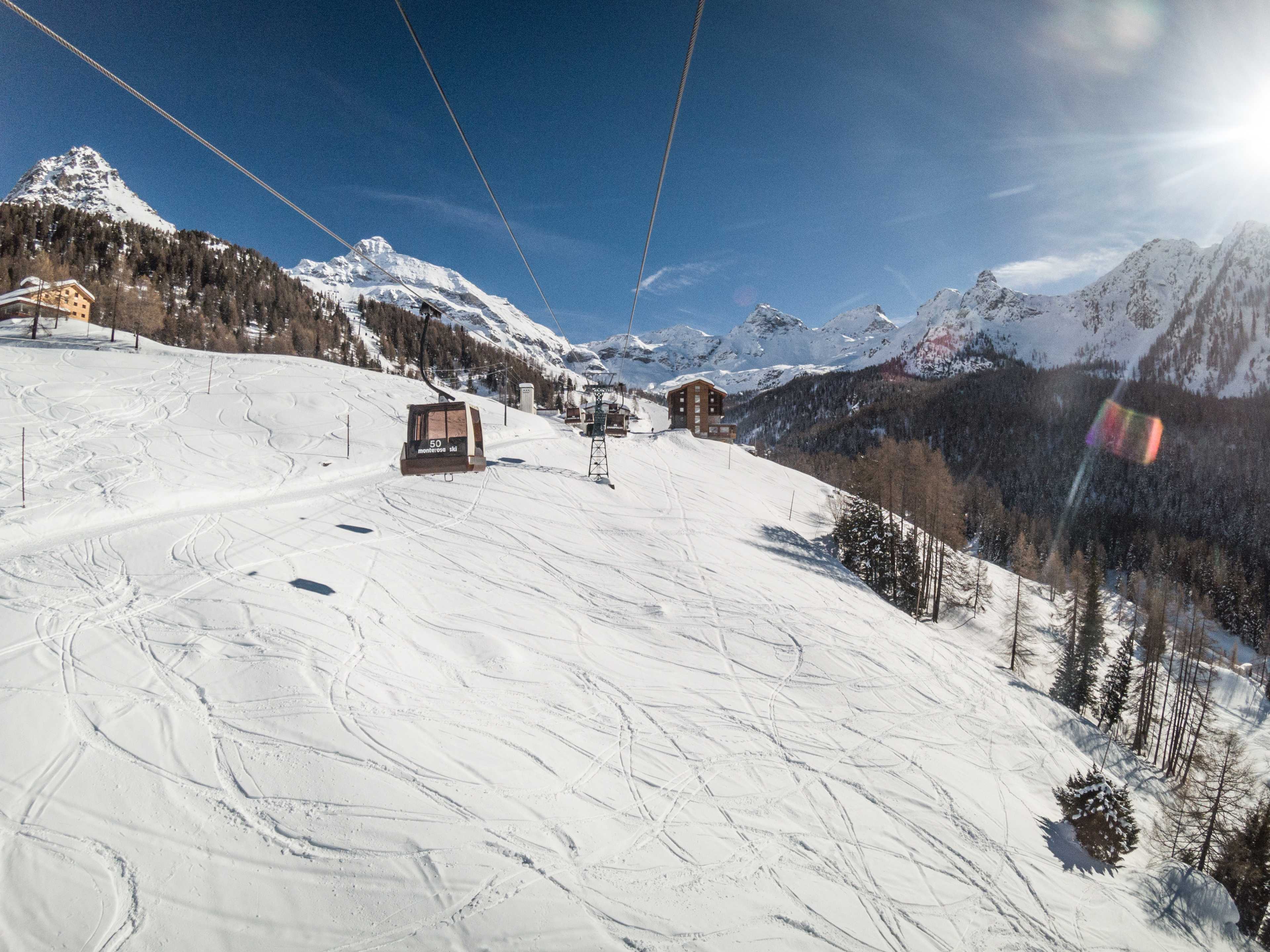
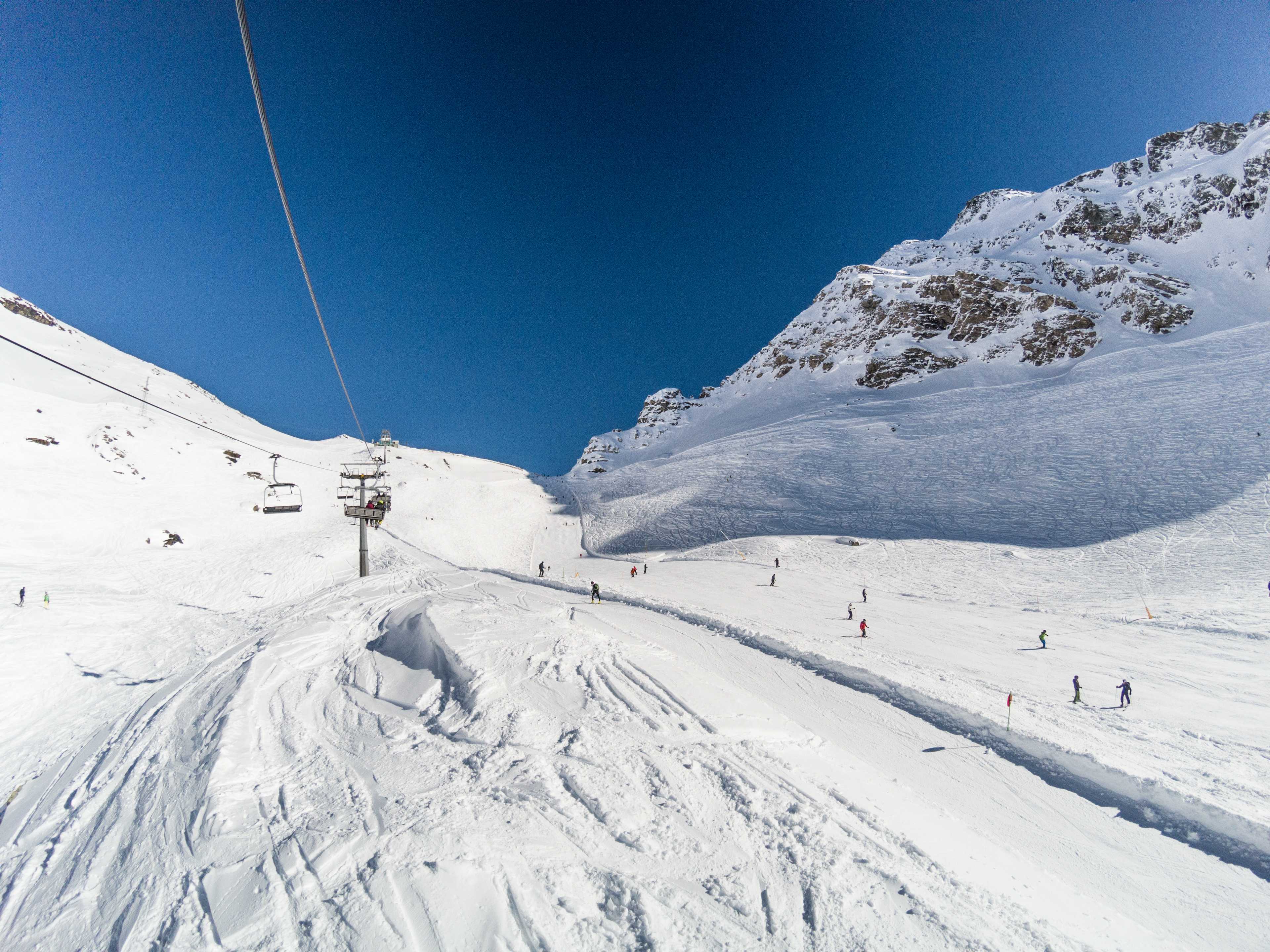
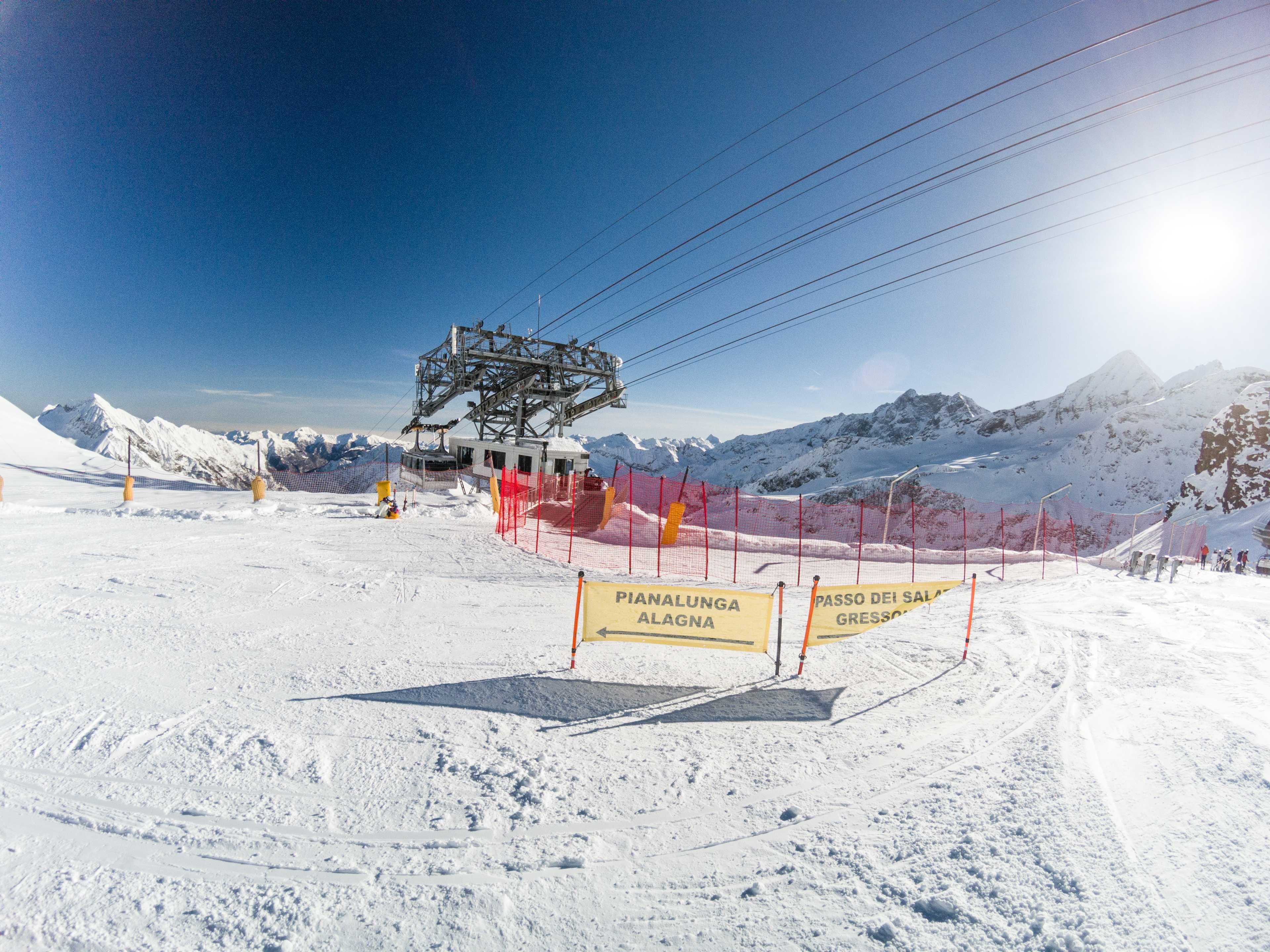
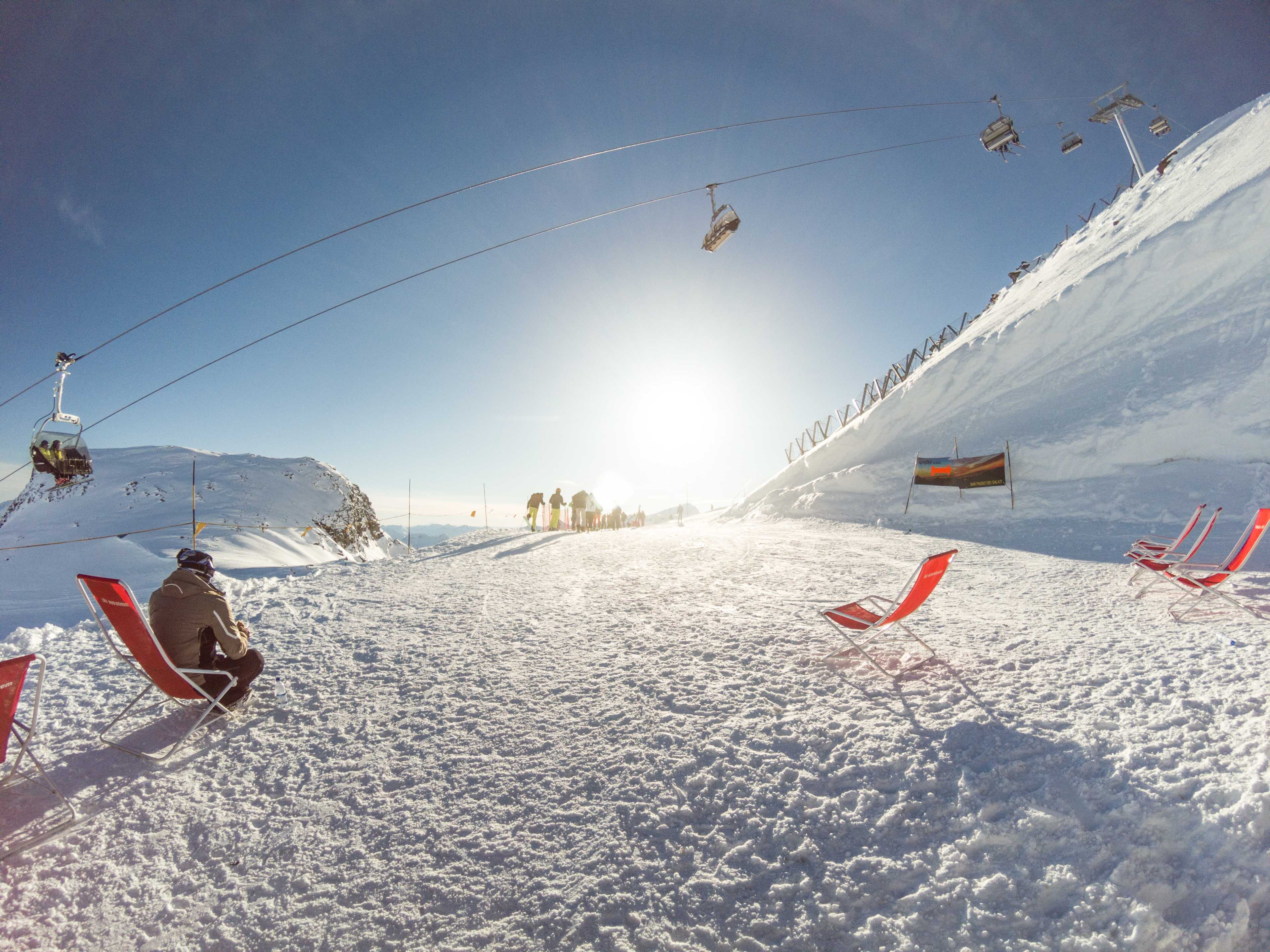
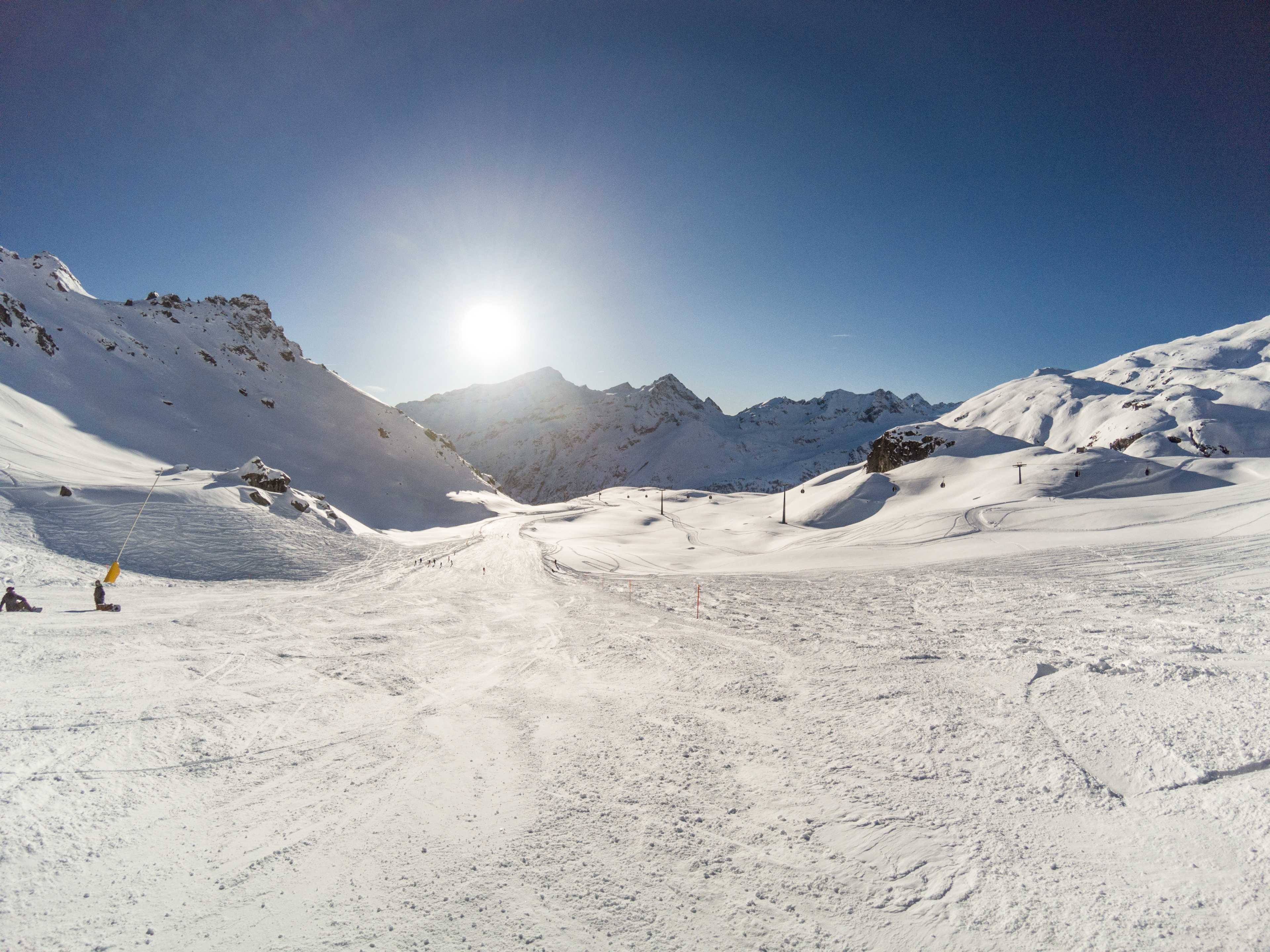
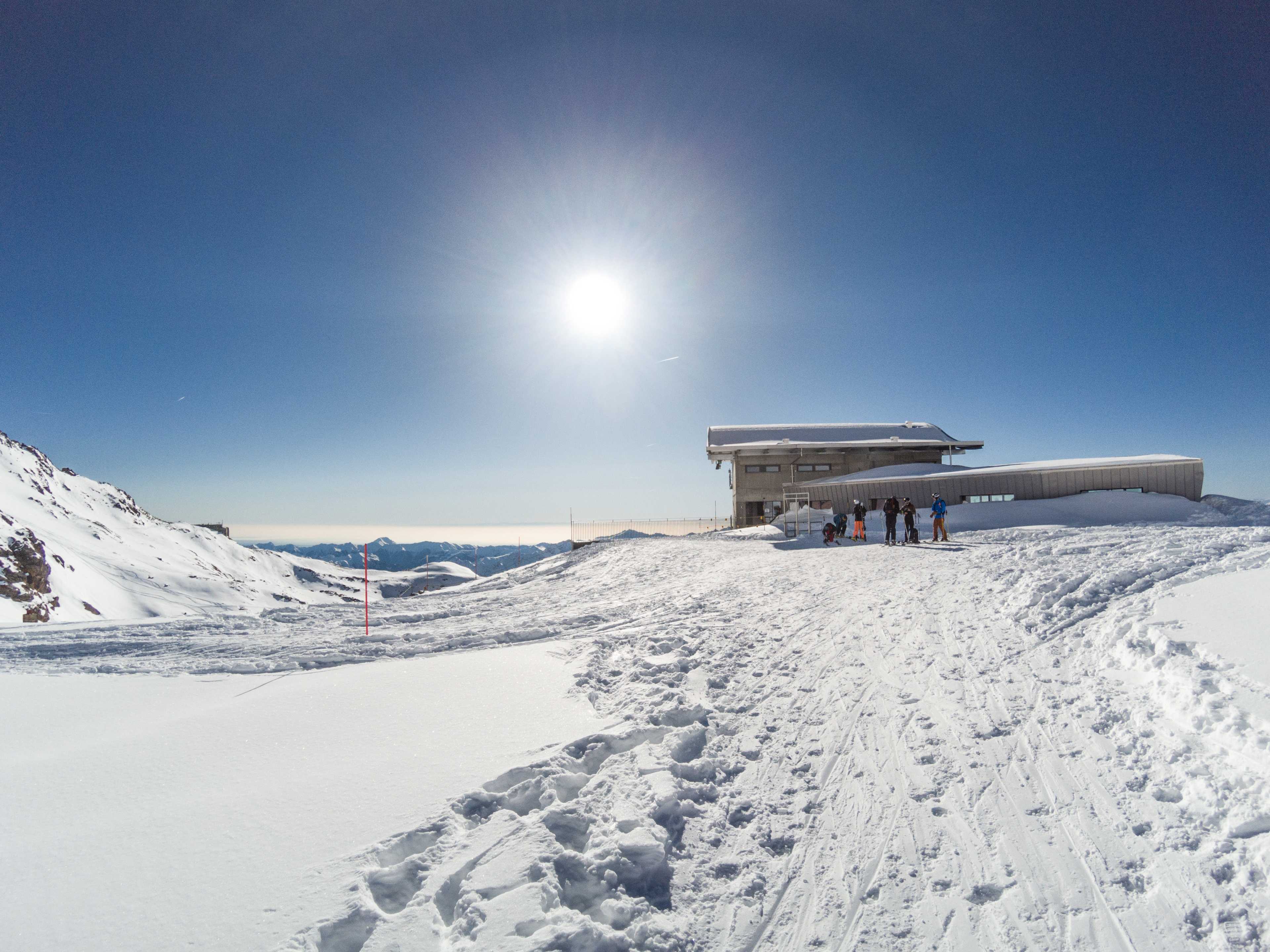
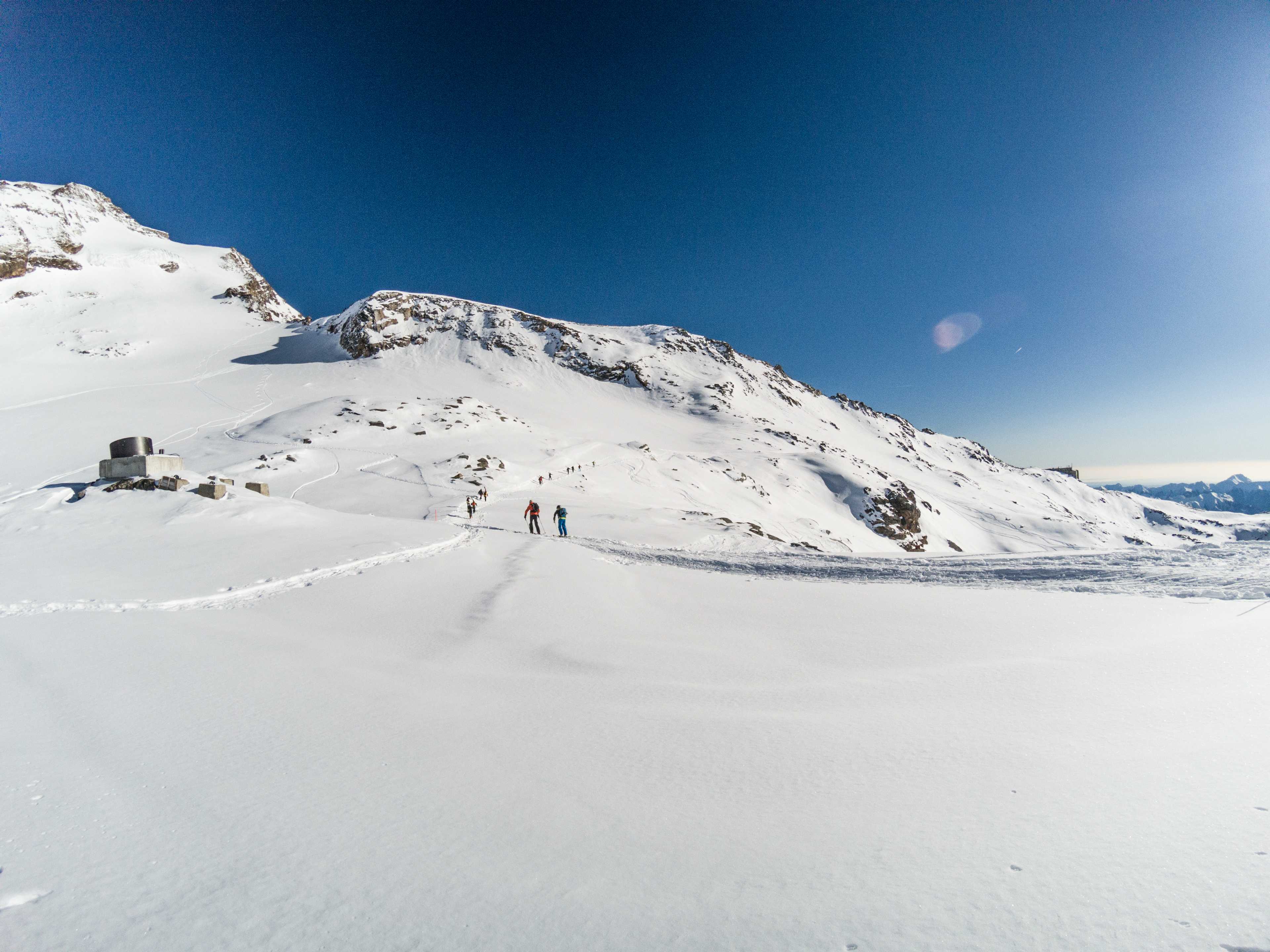
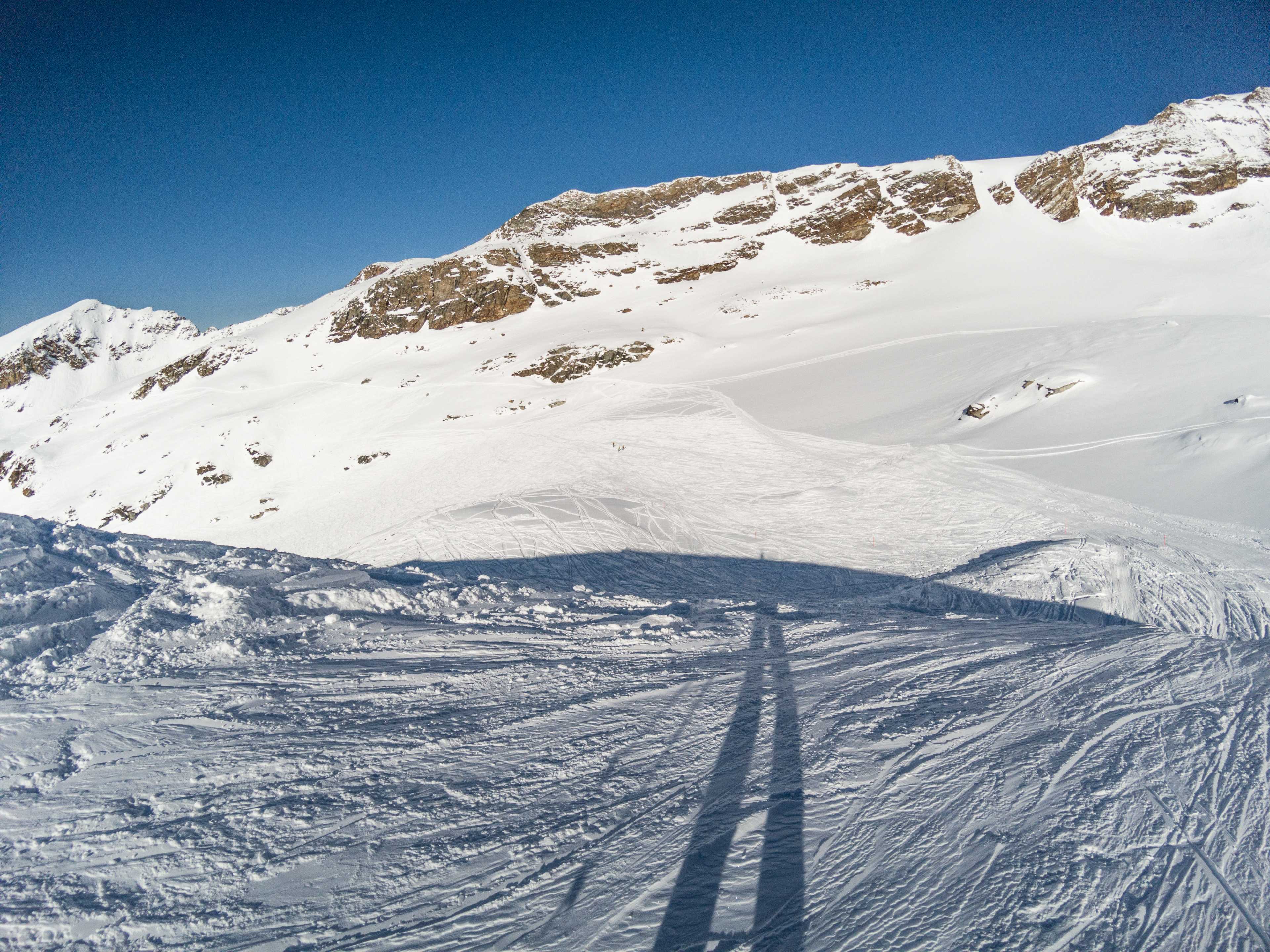
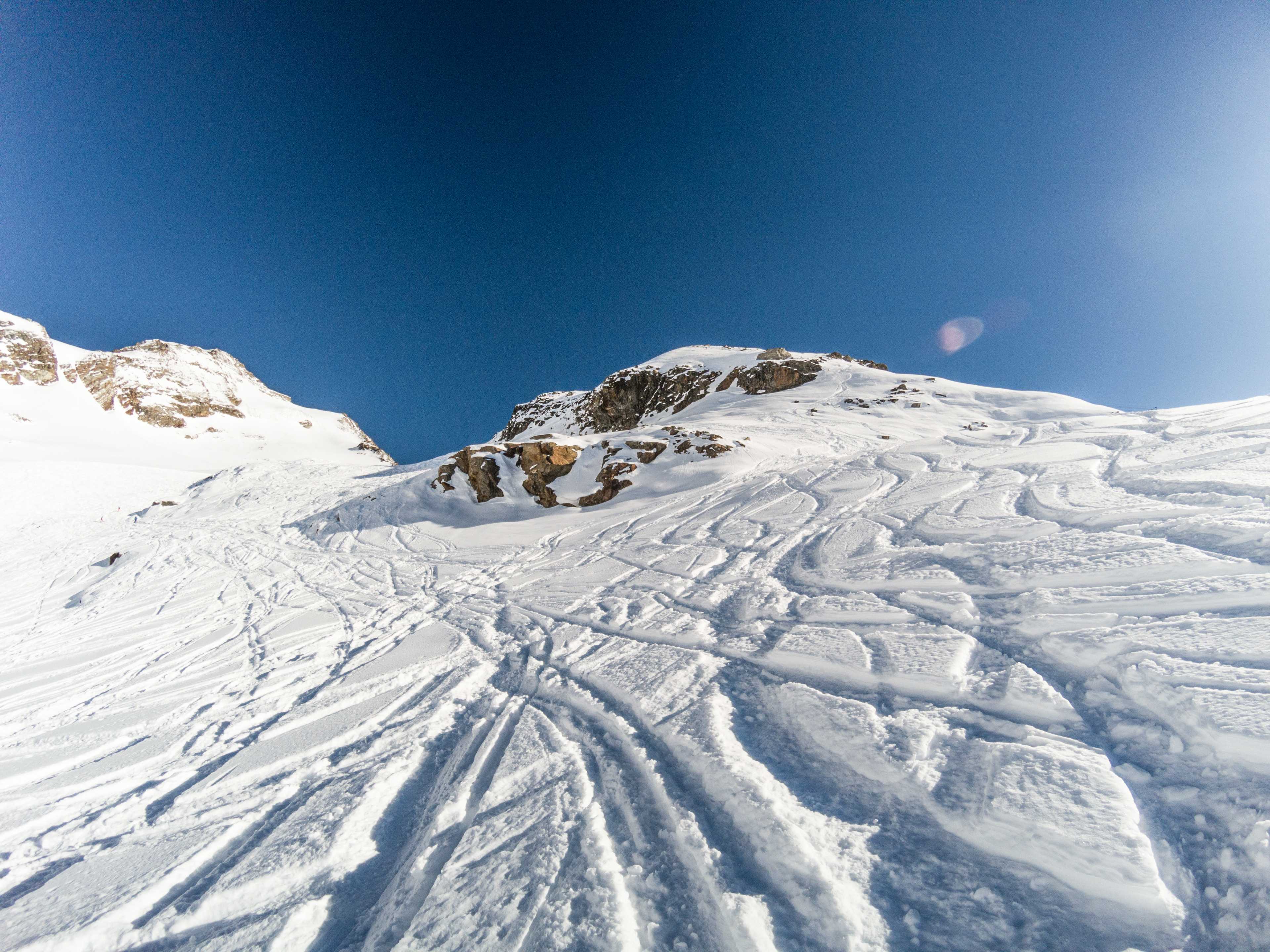
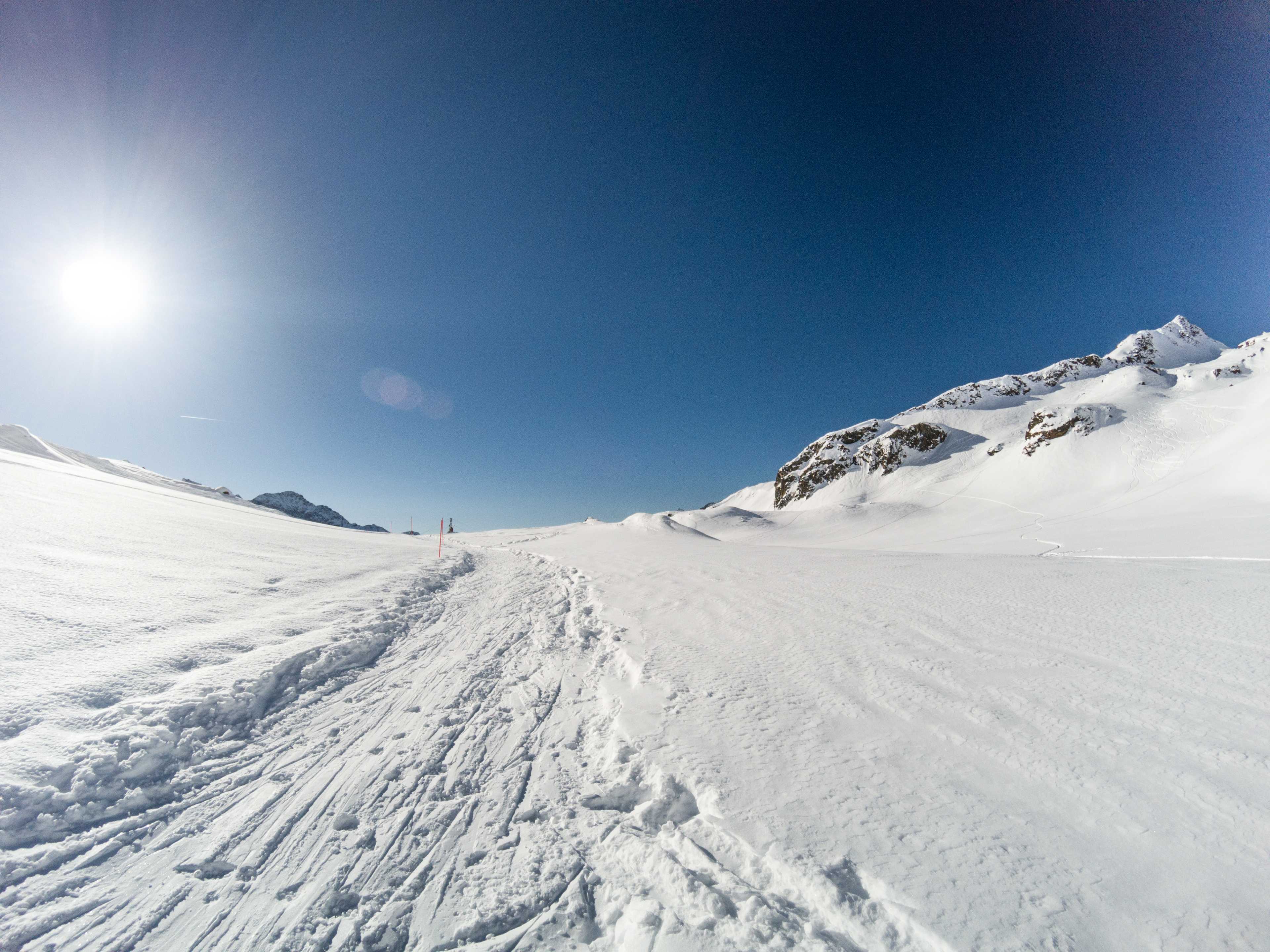
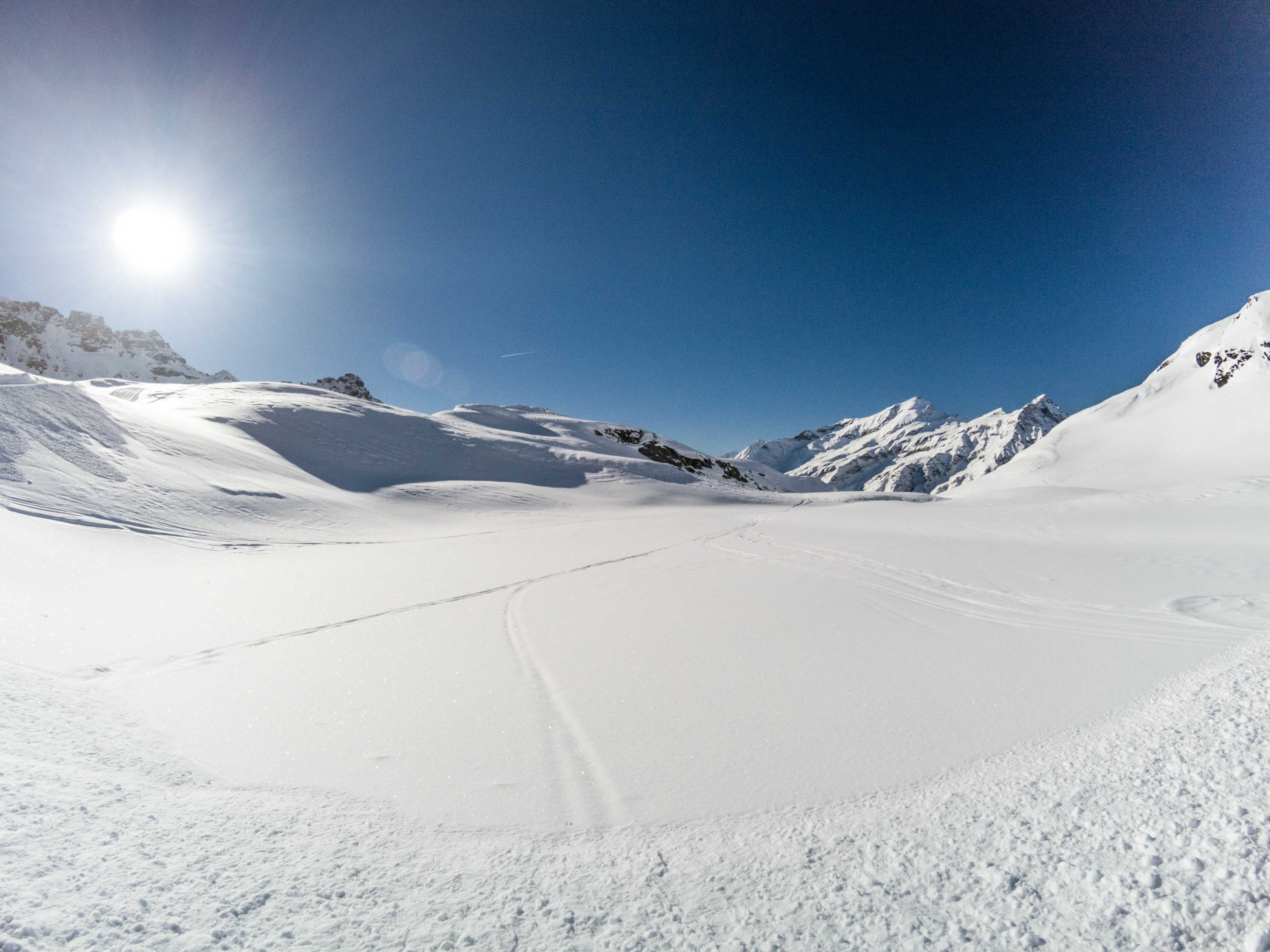
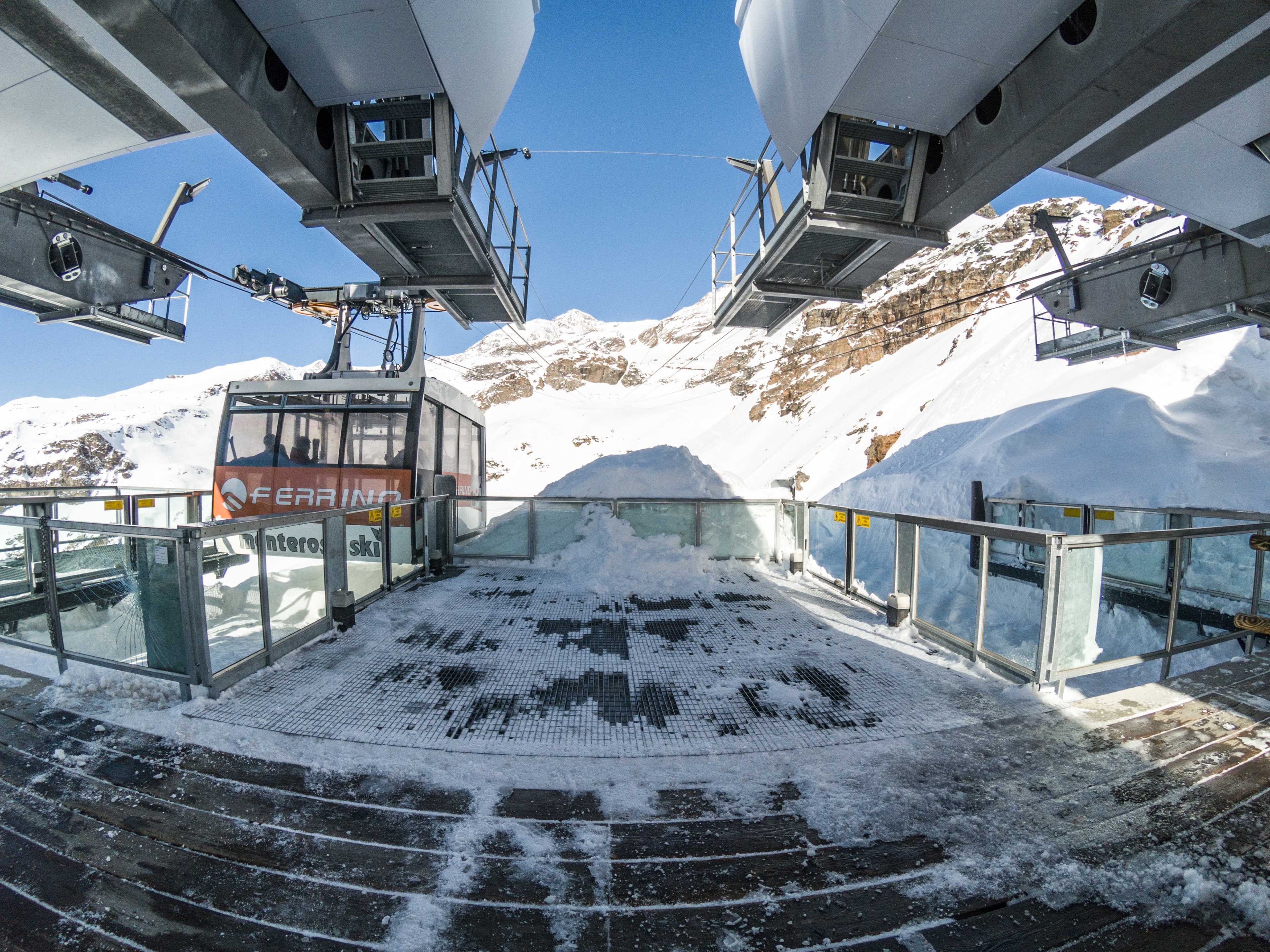
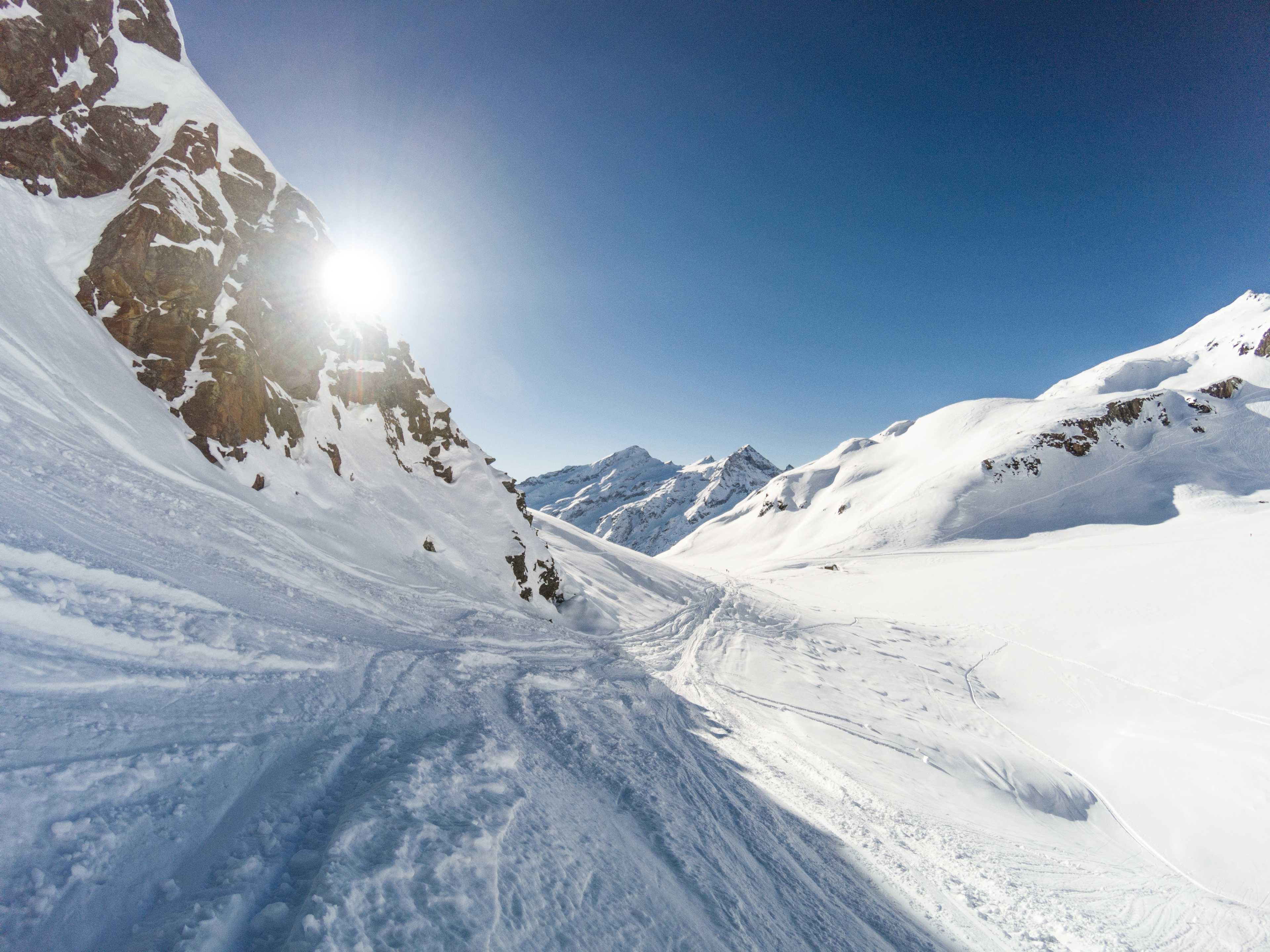
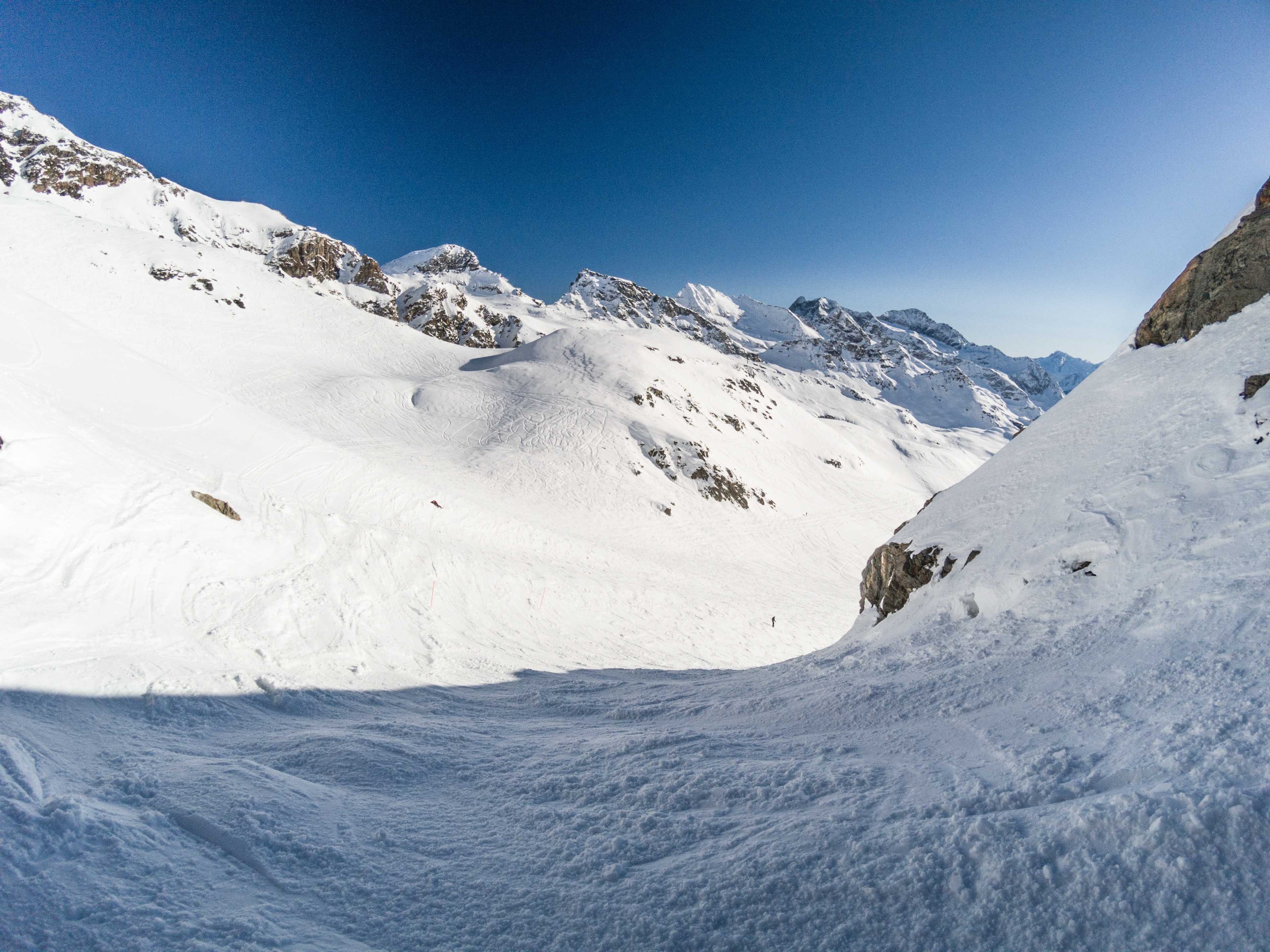
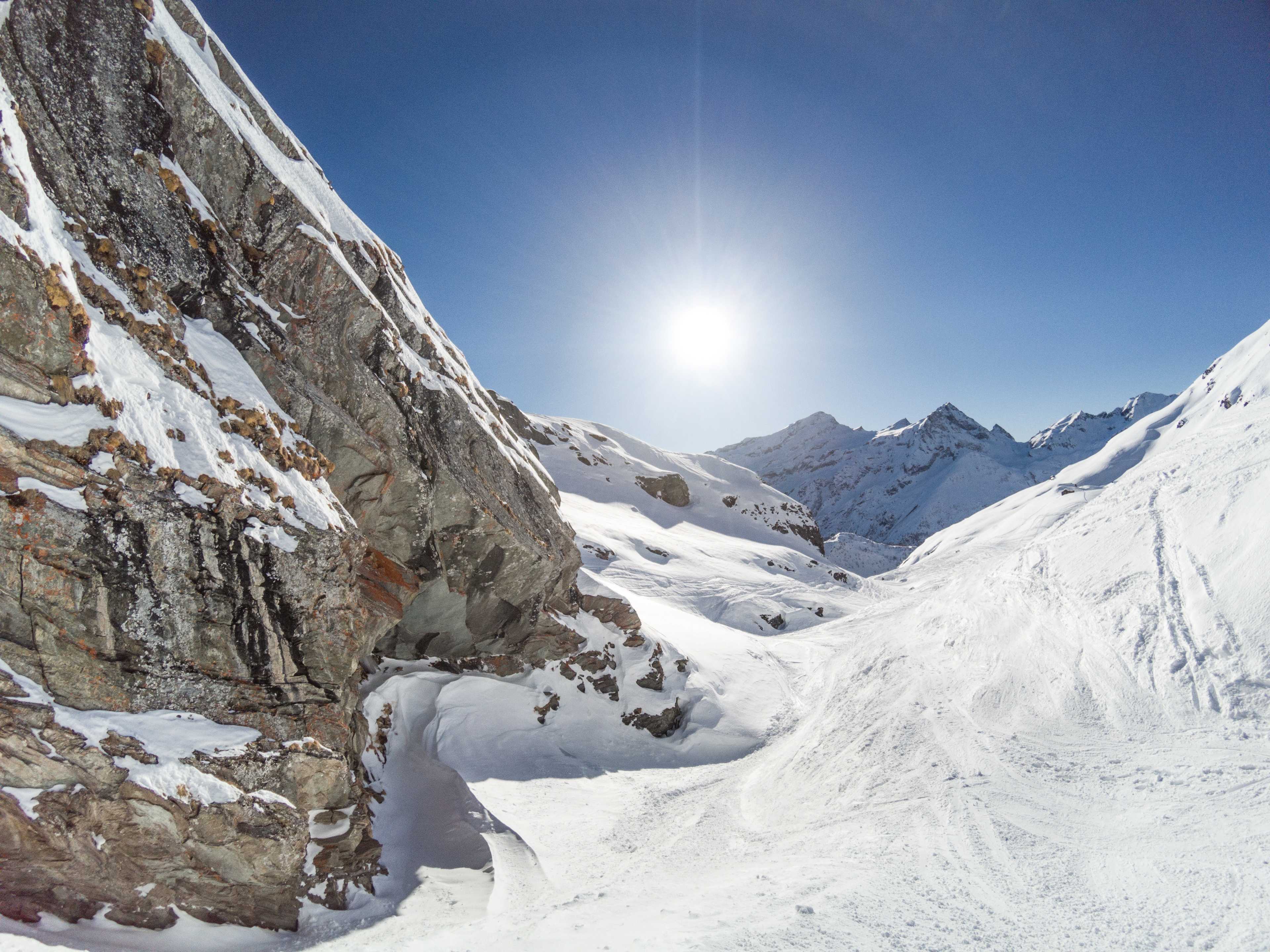
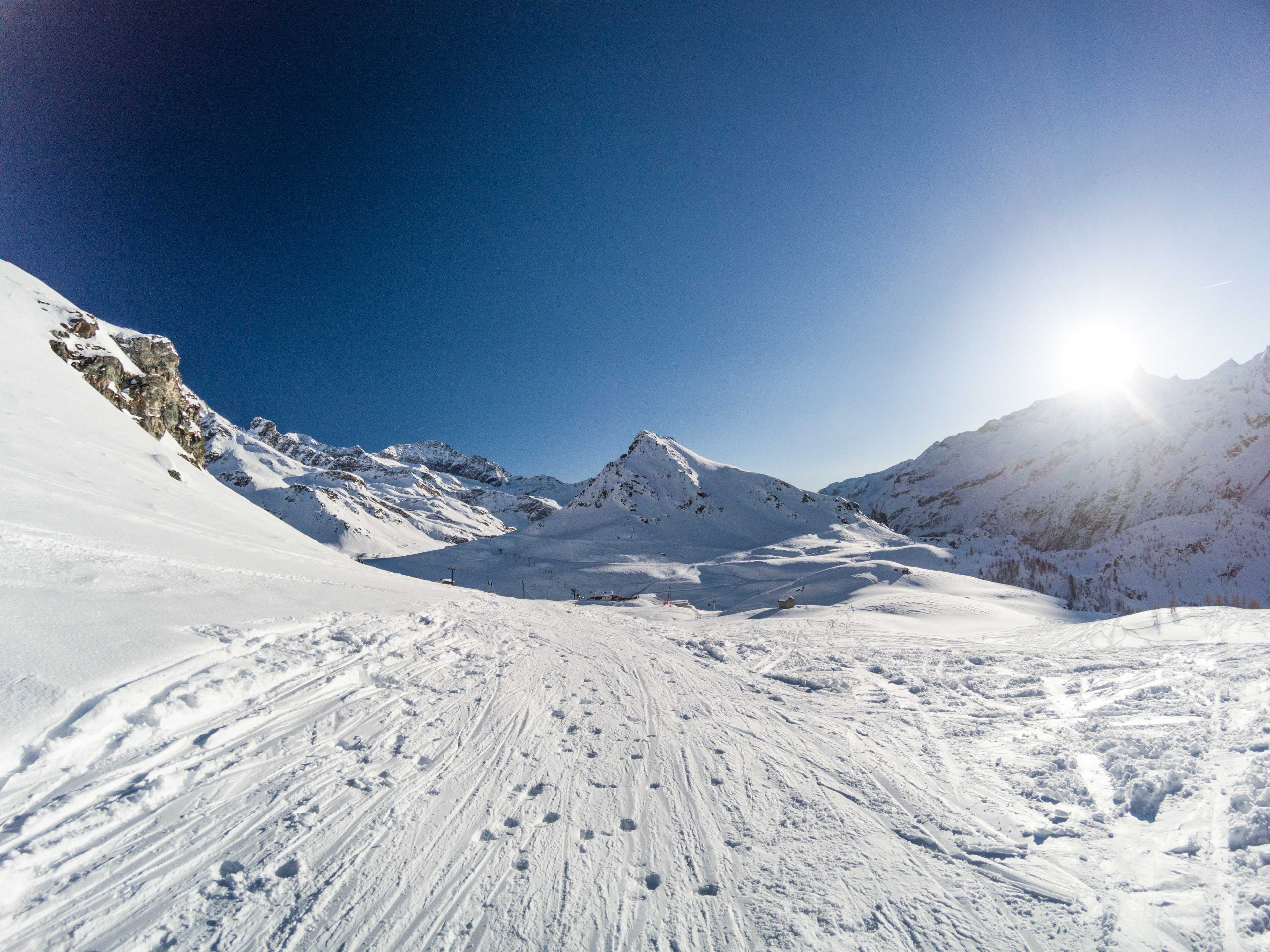
Read also
